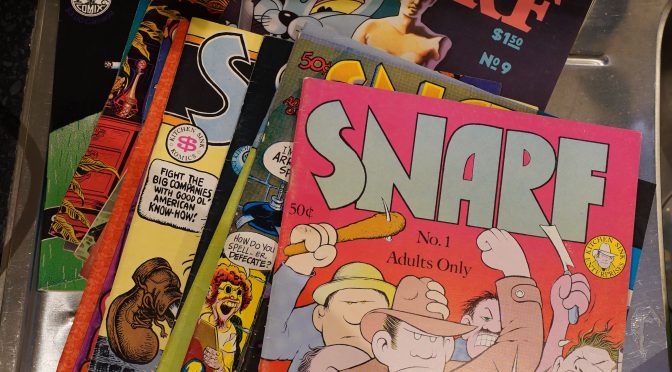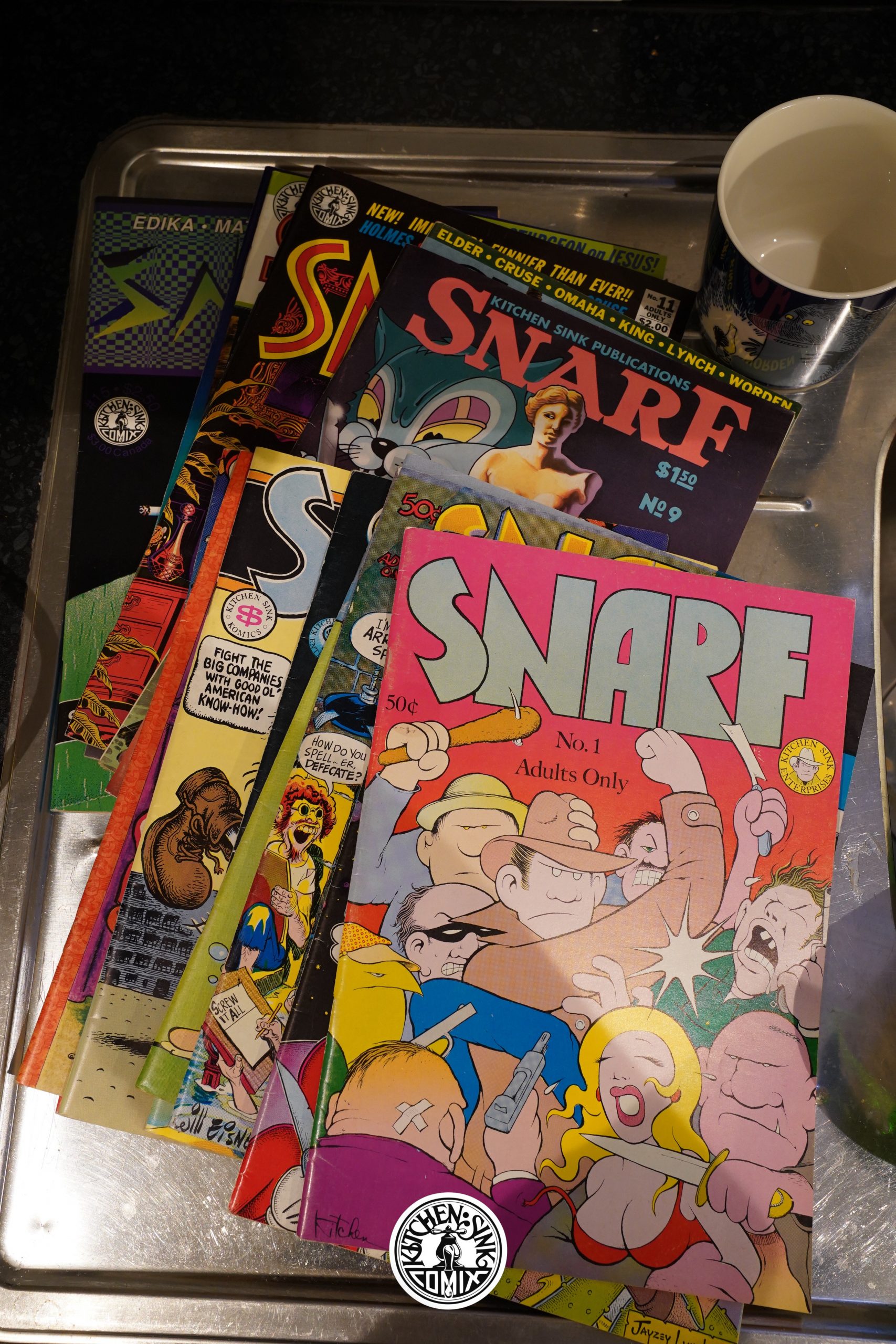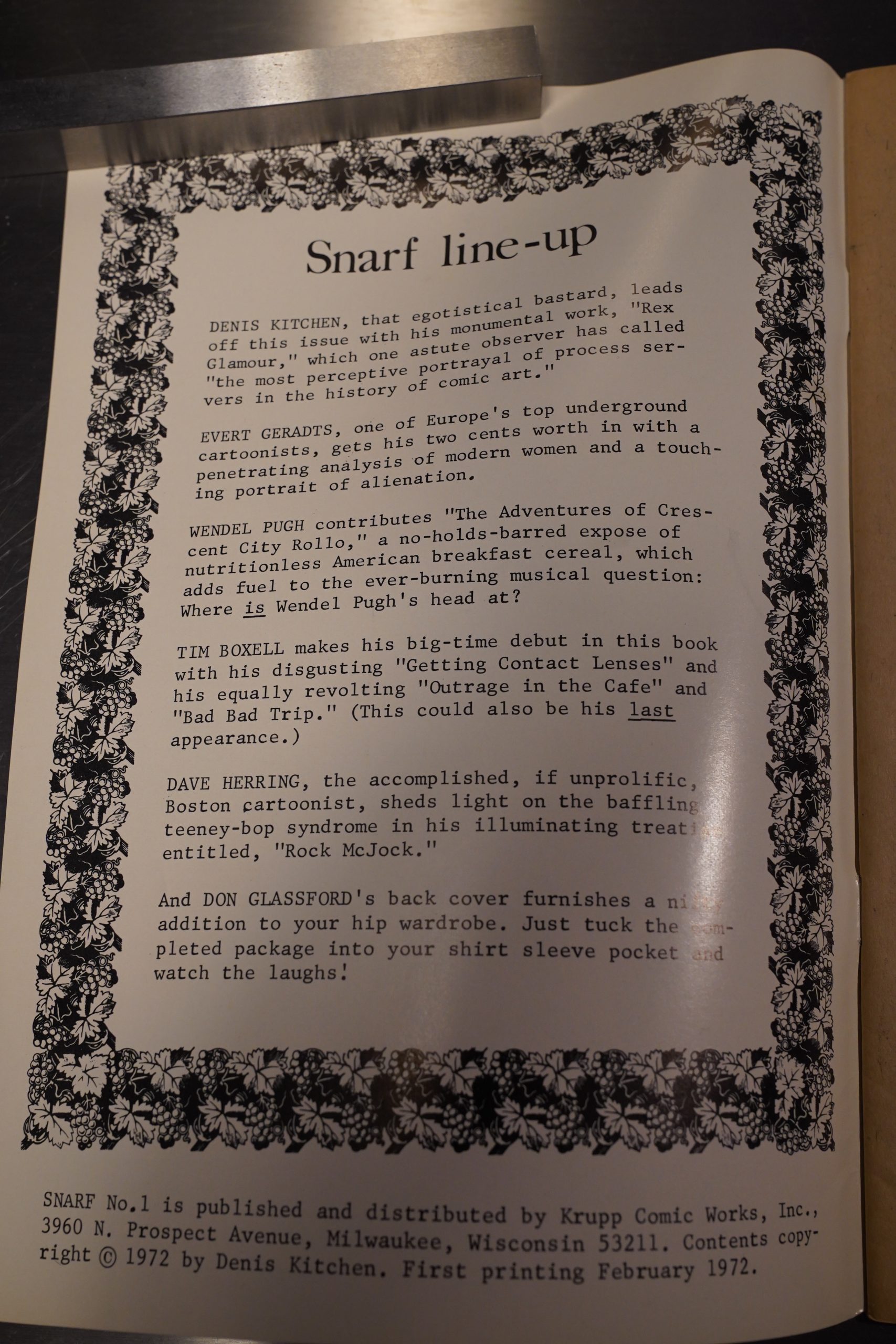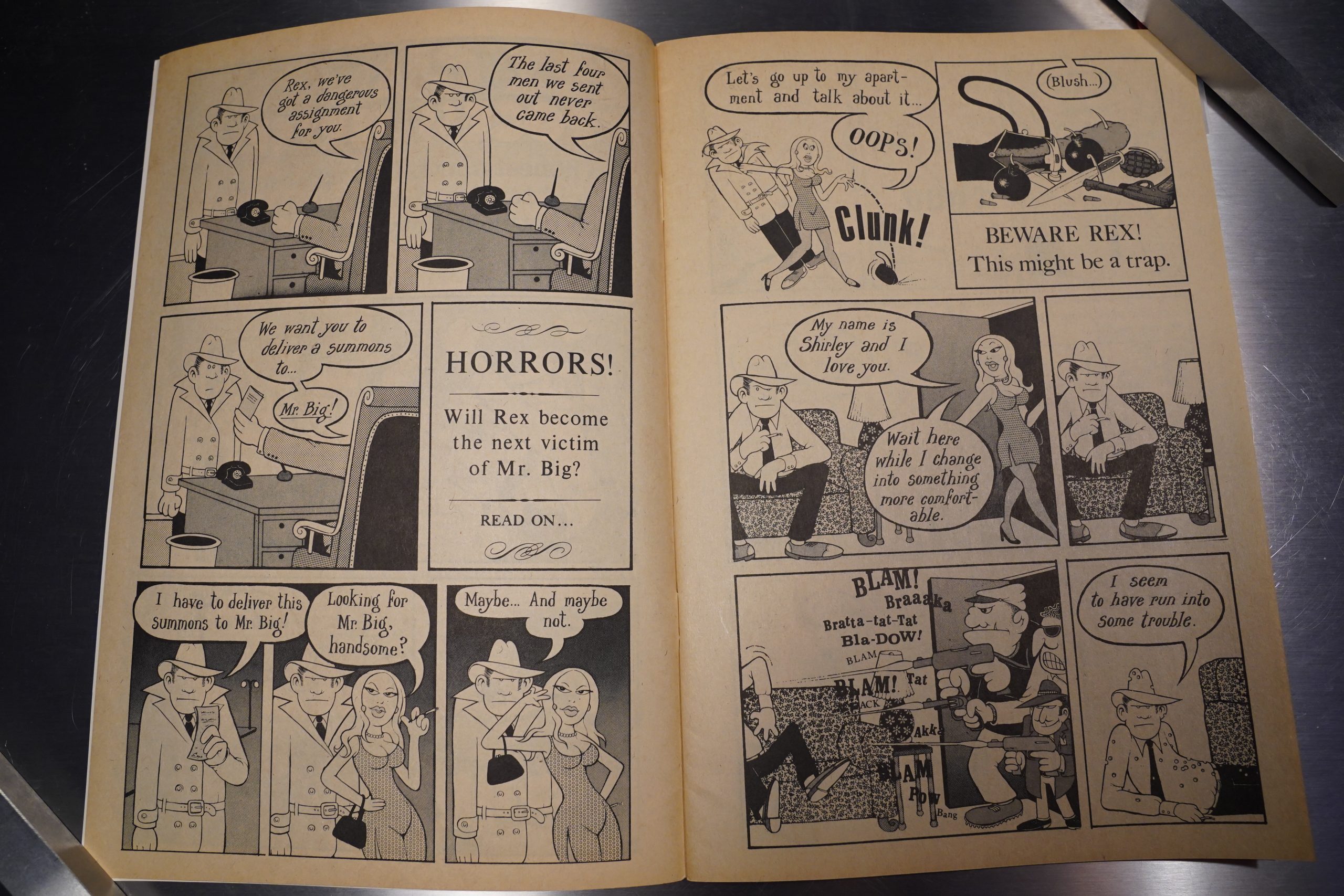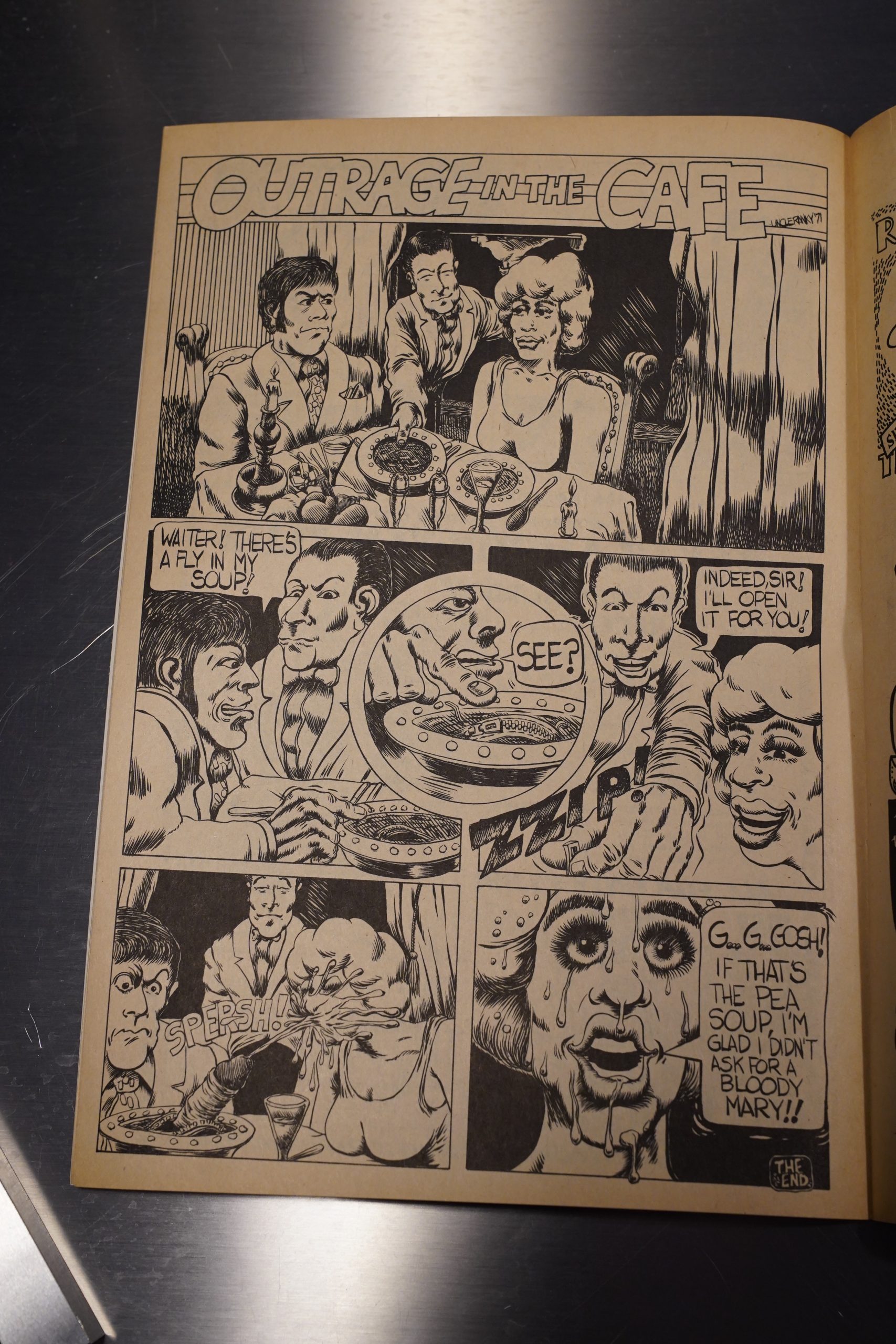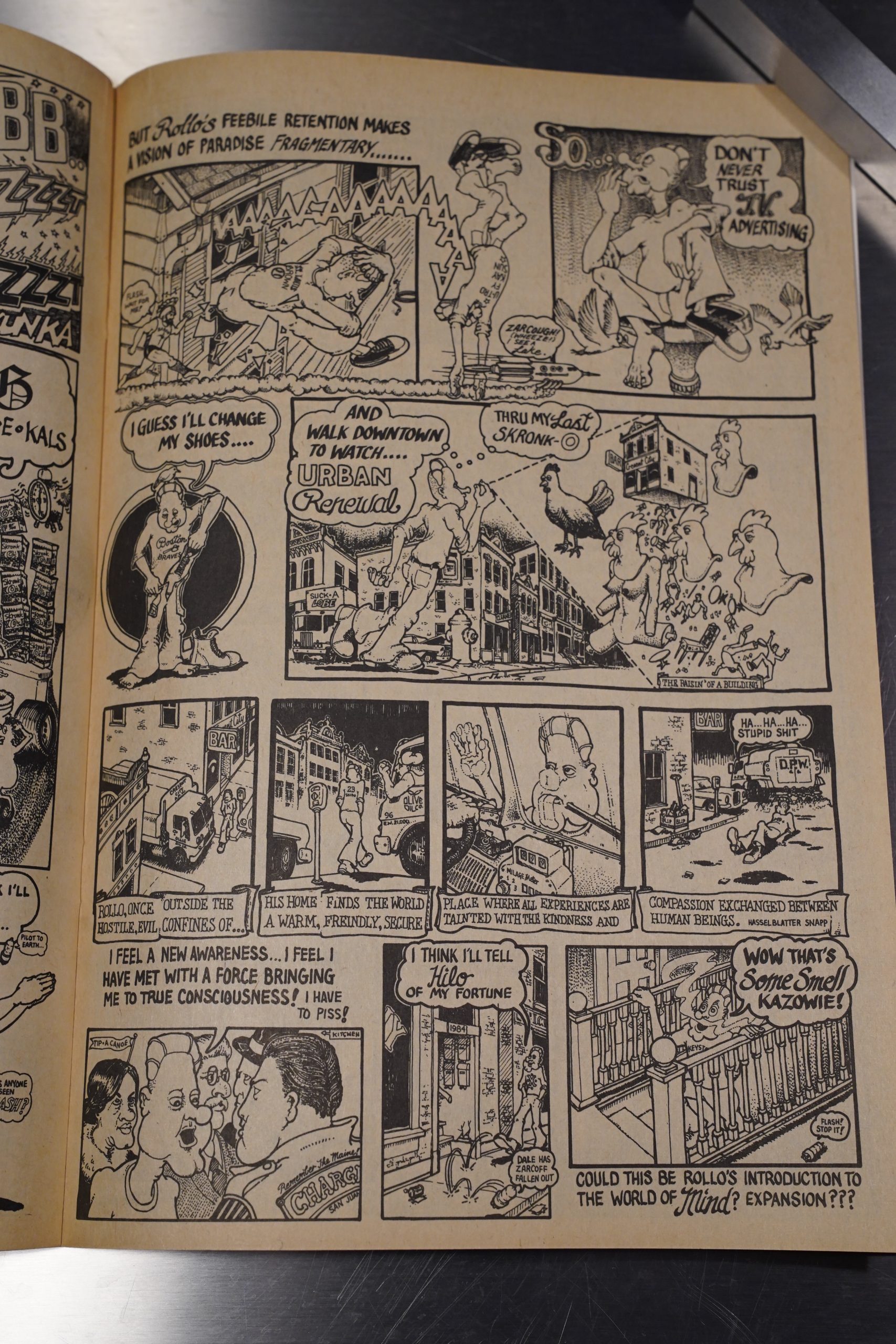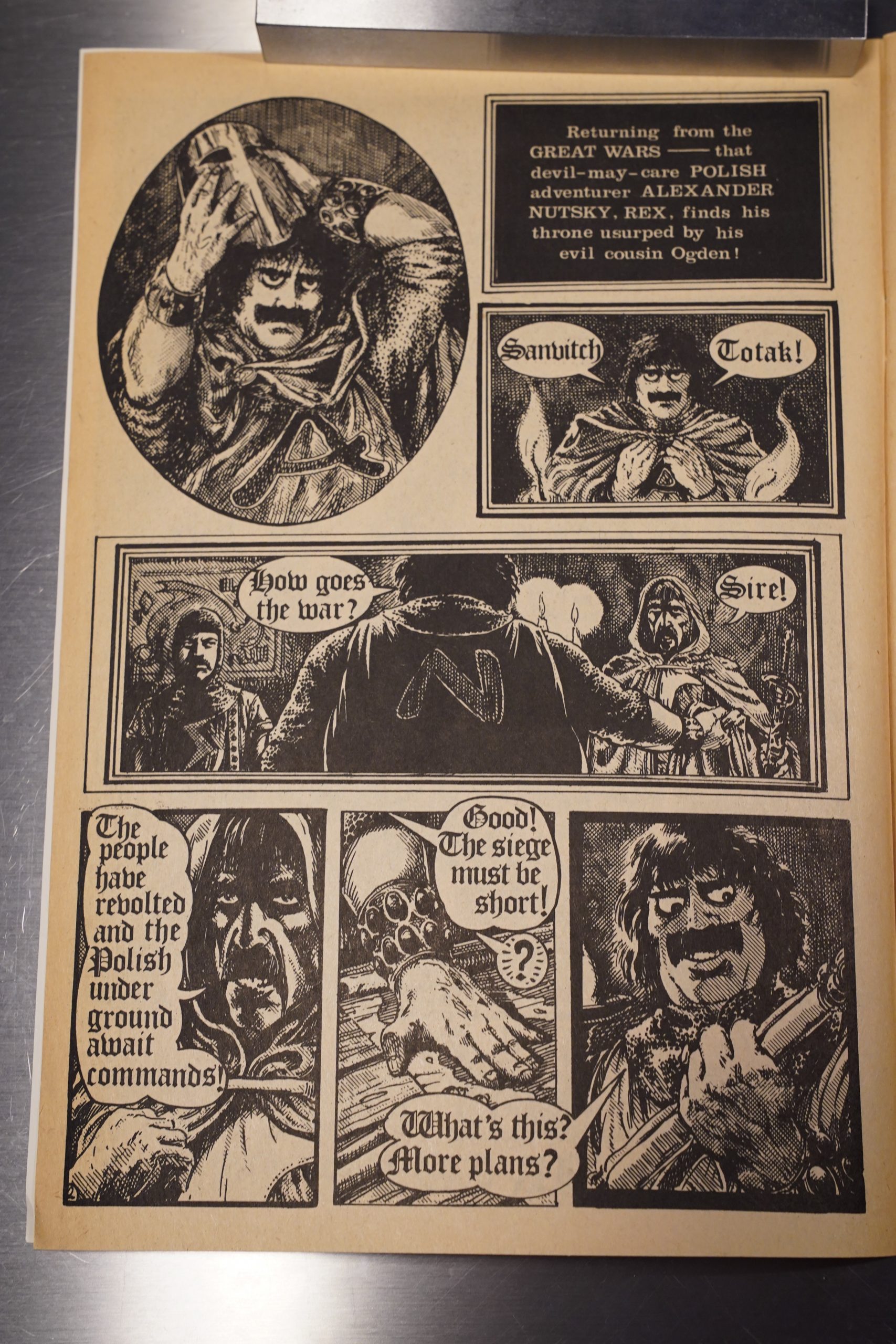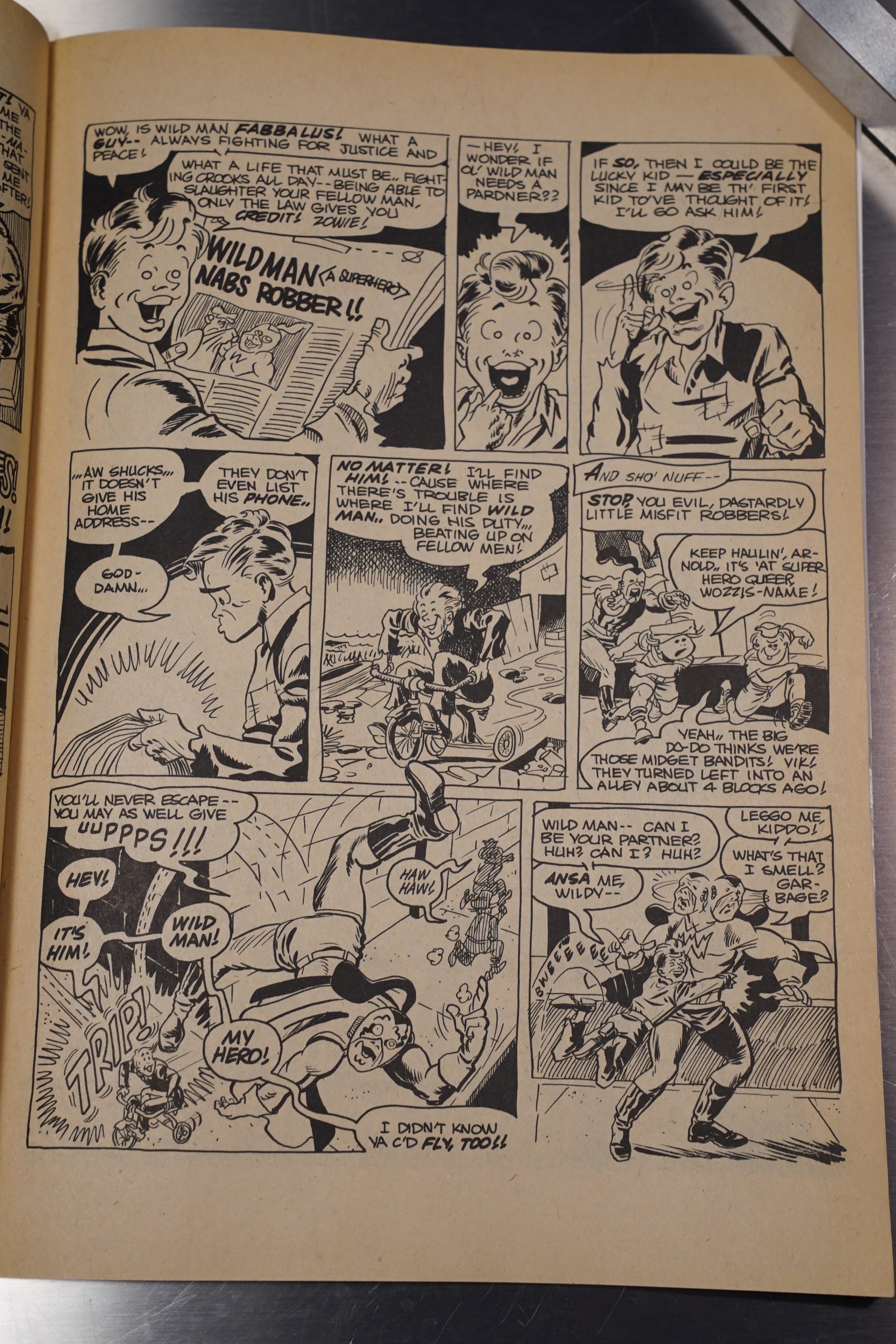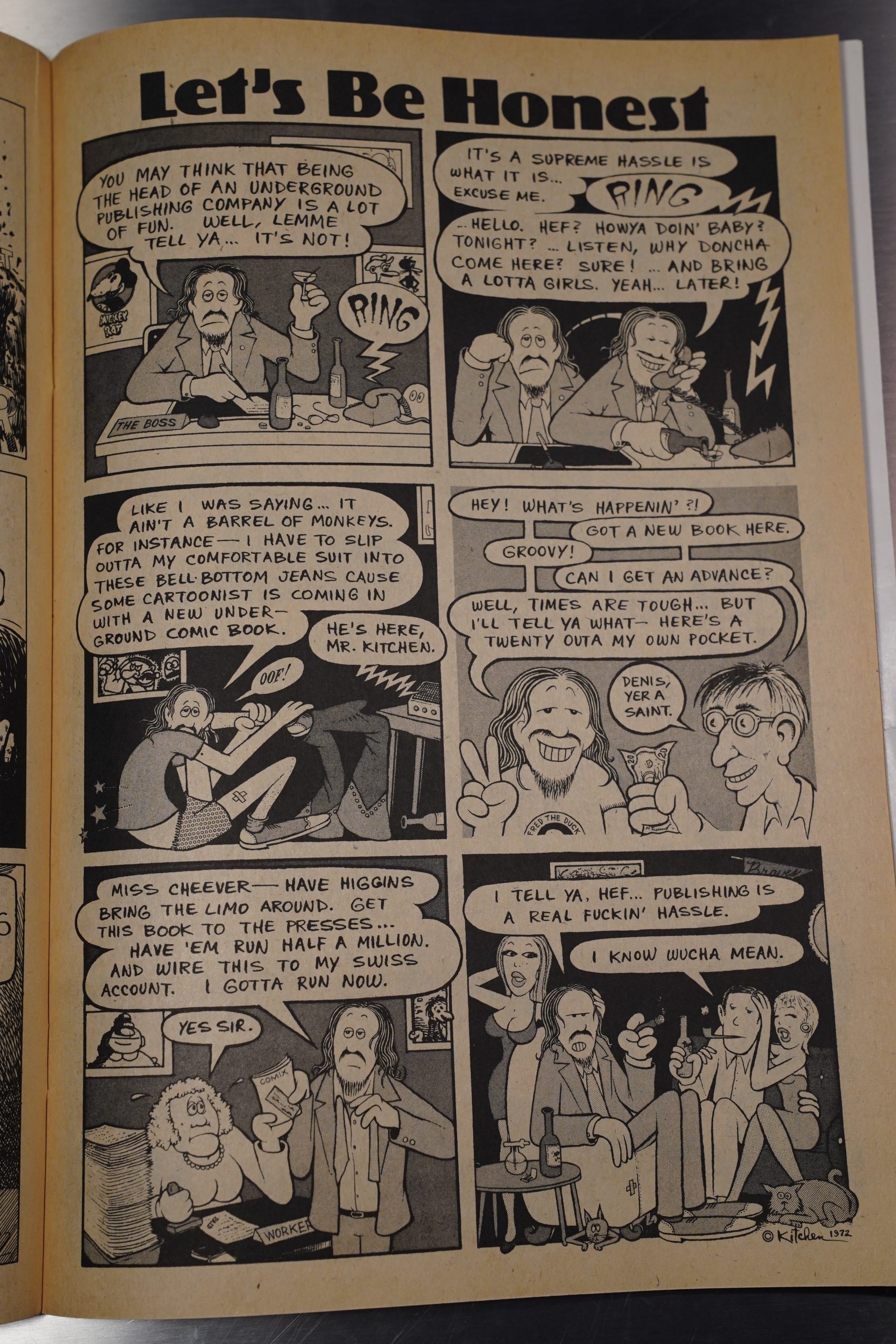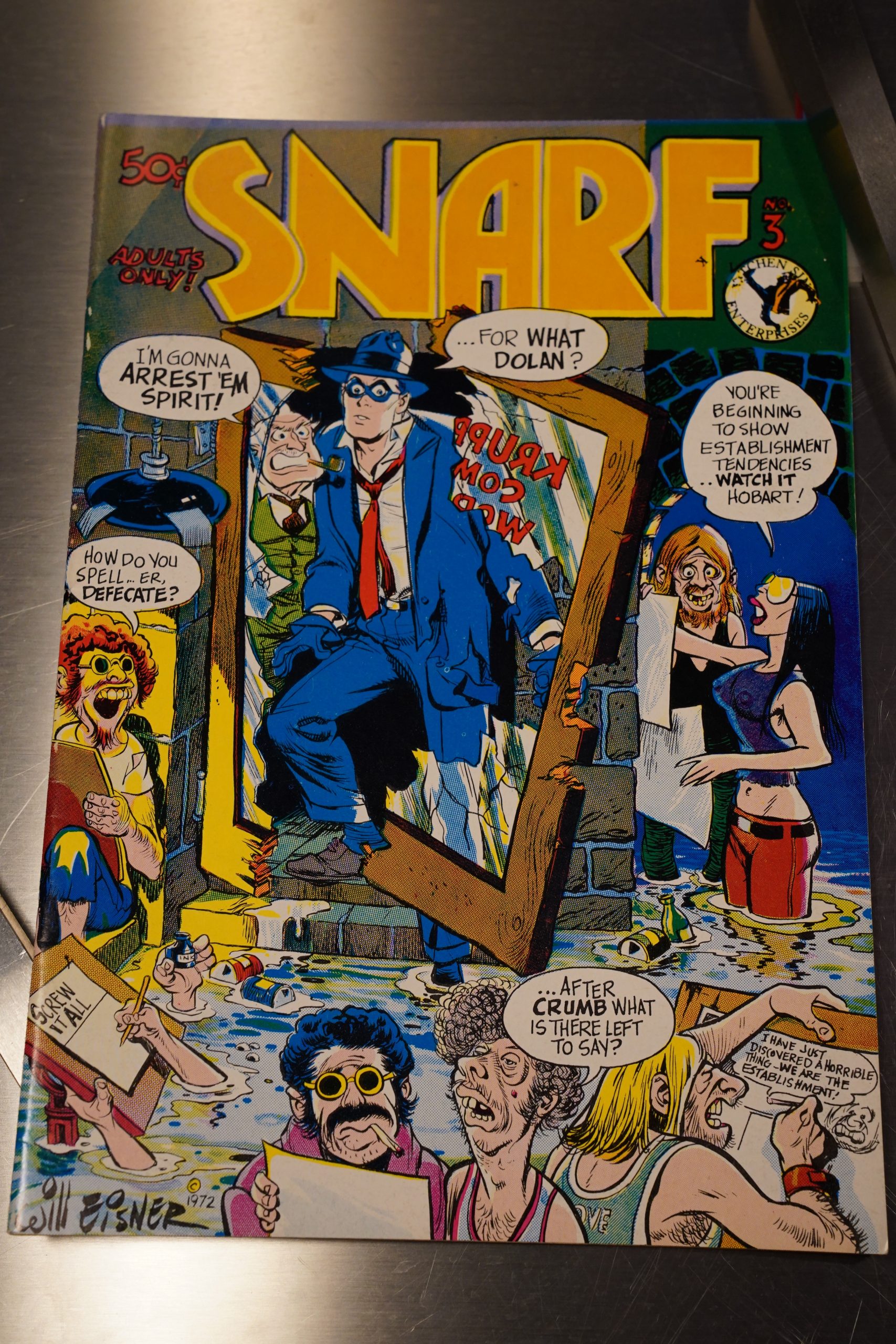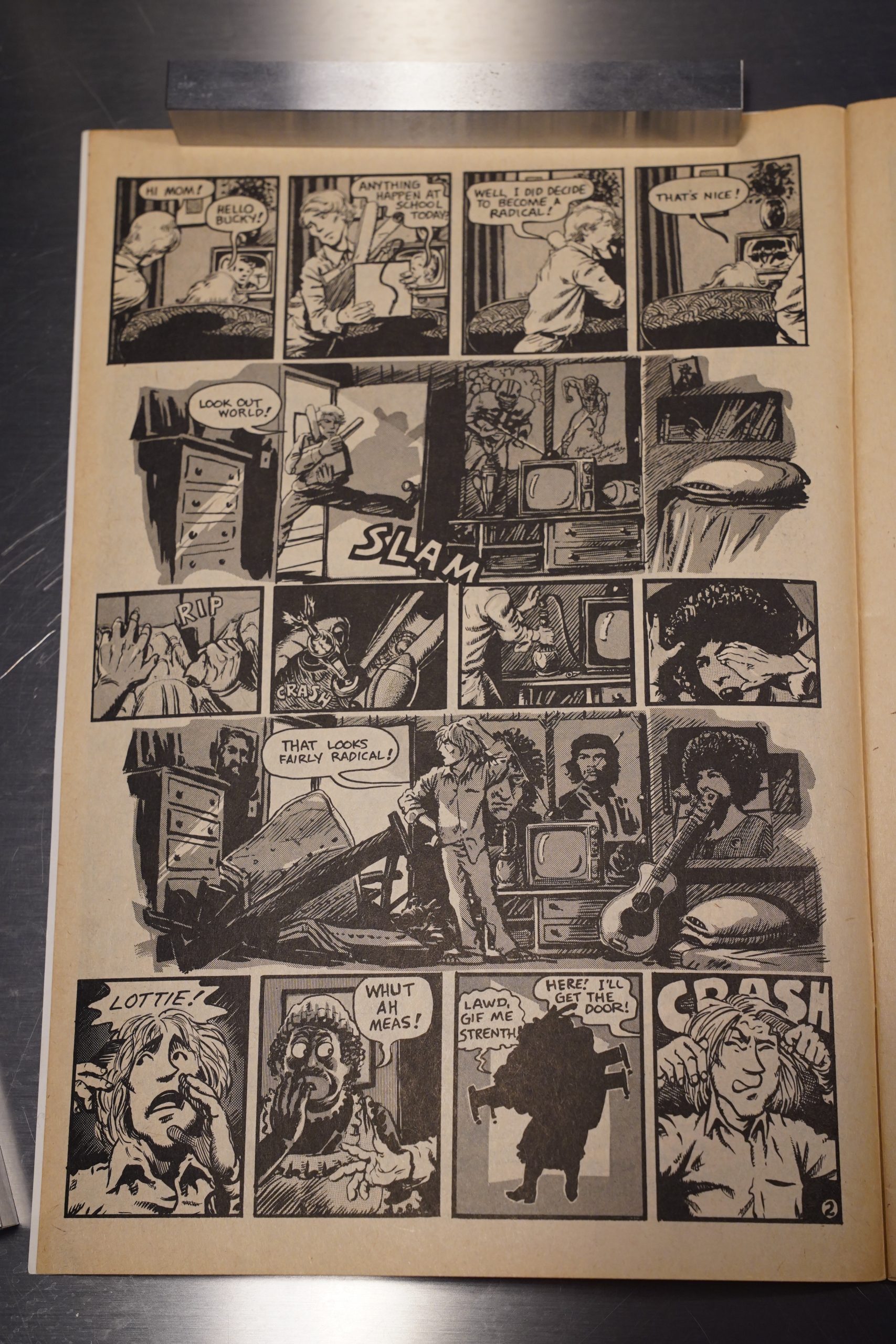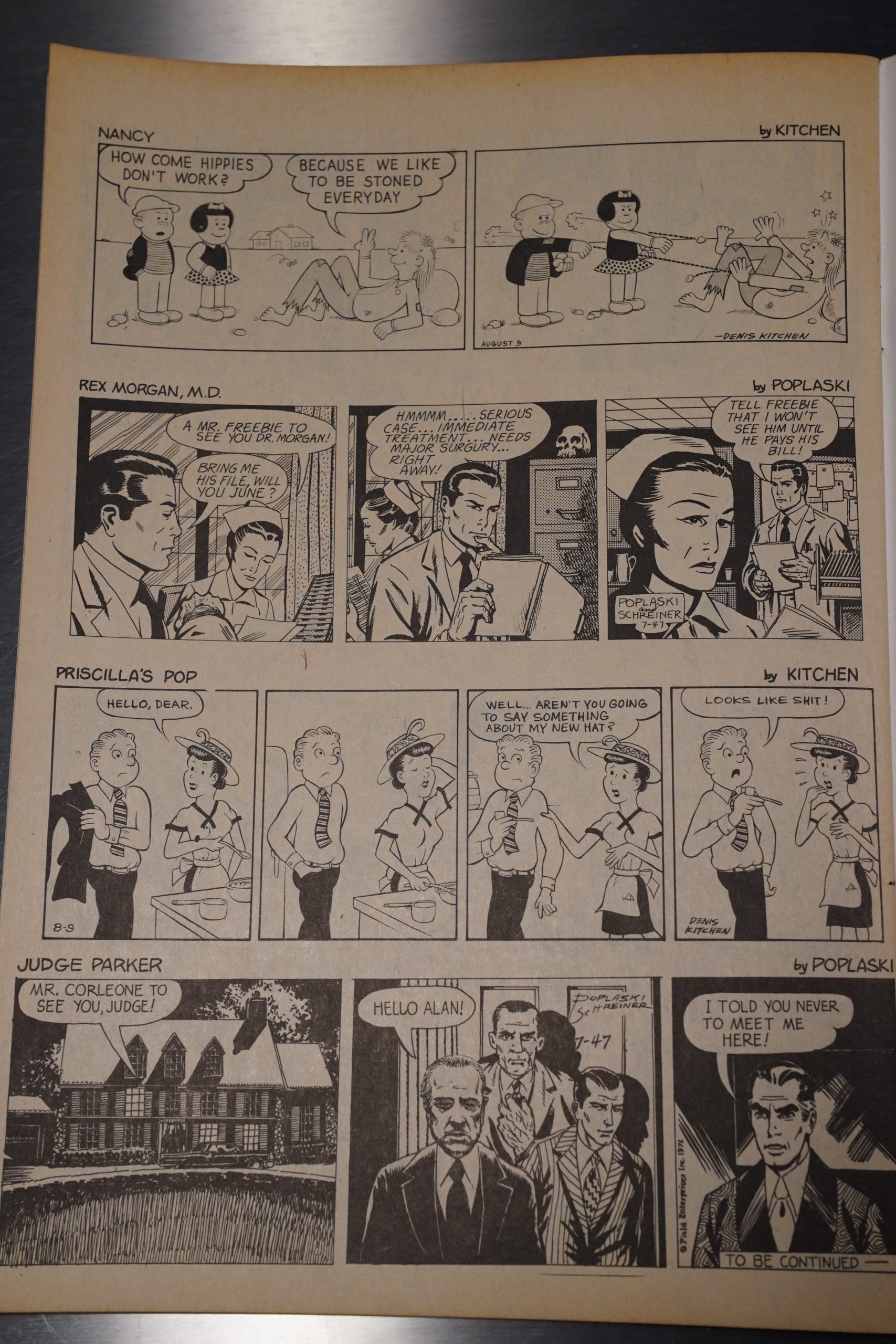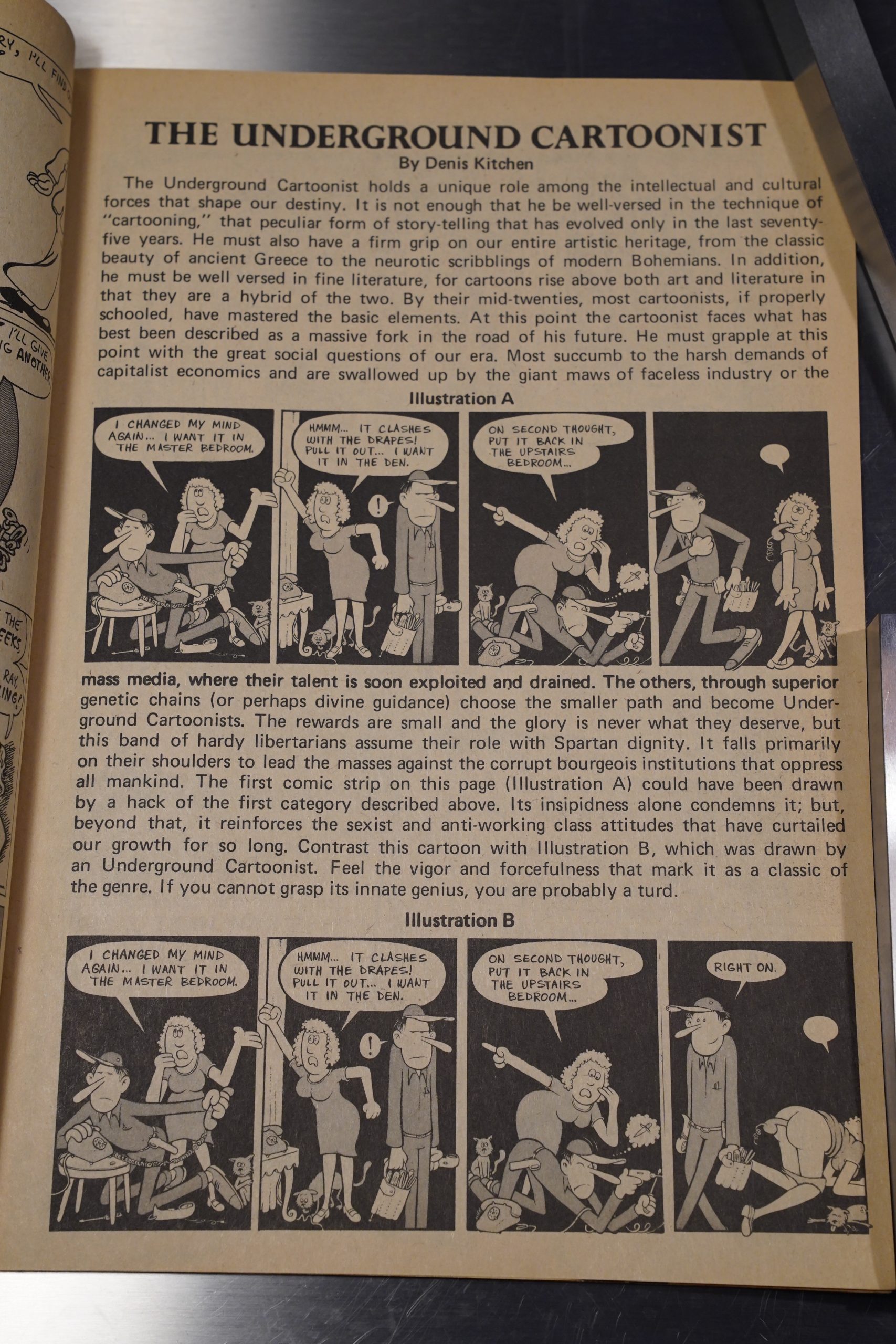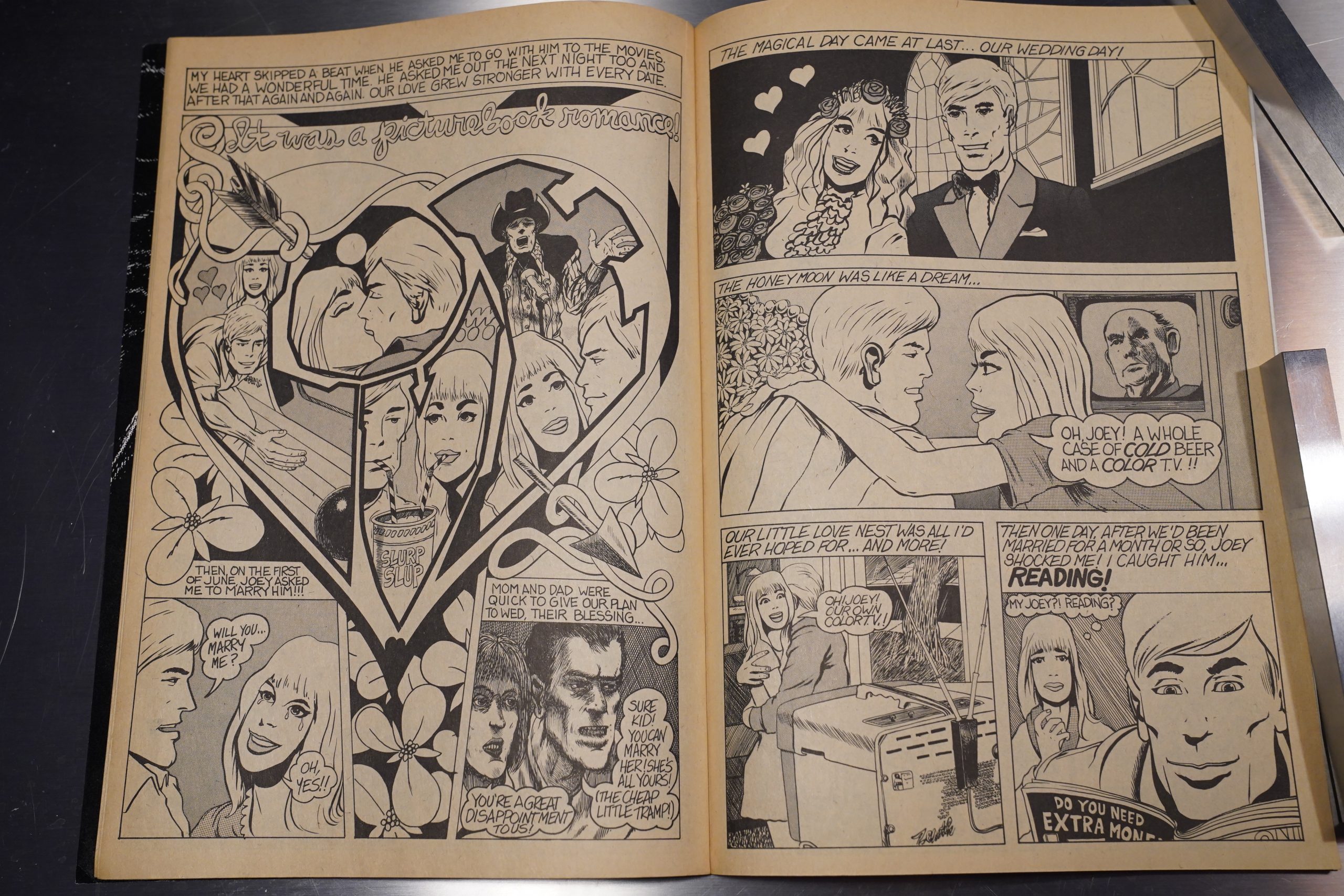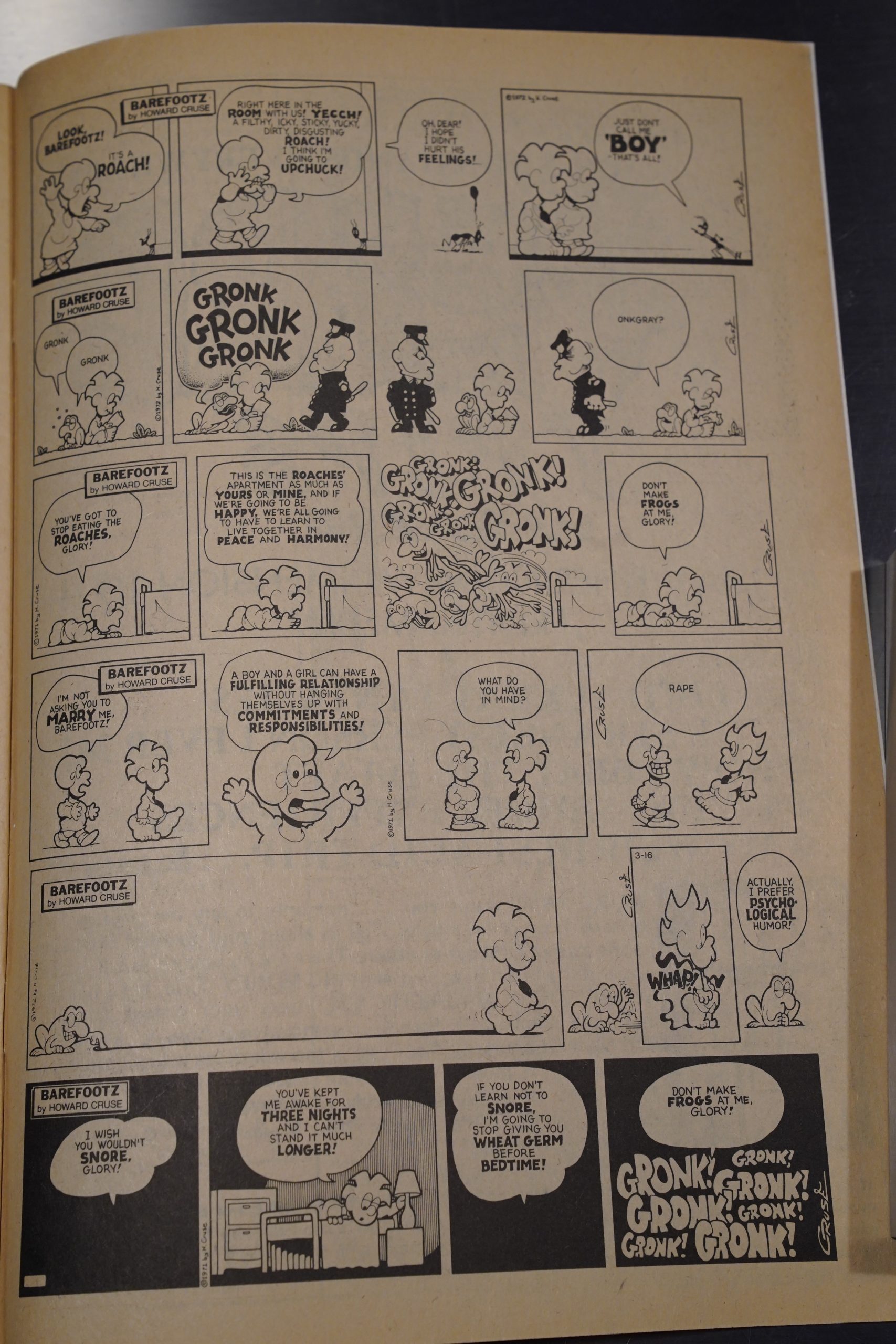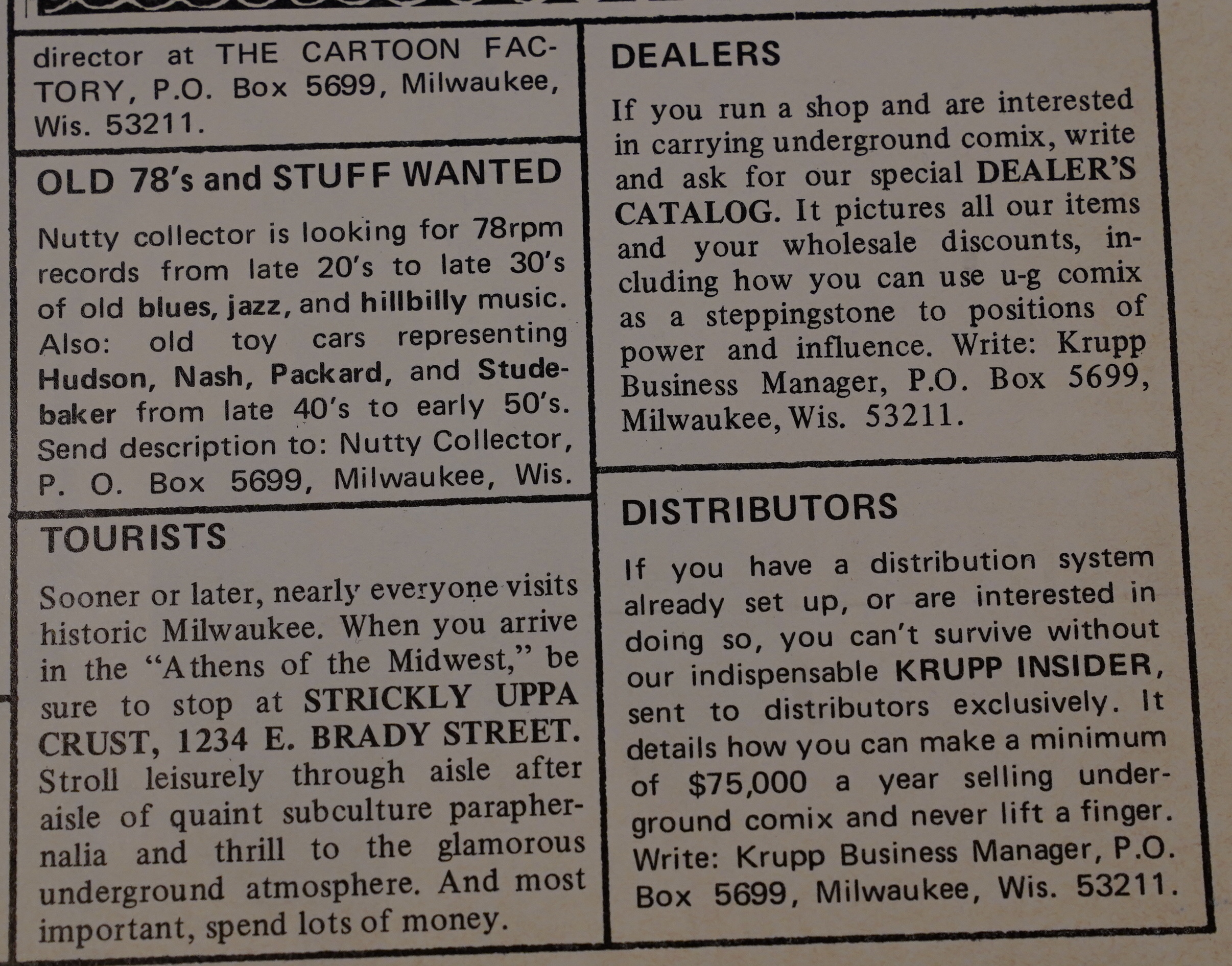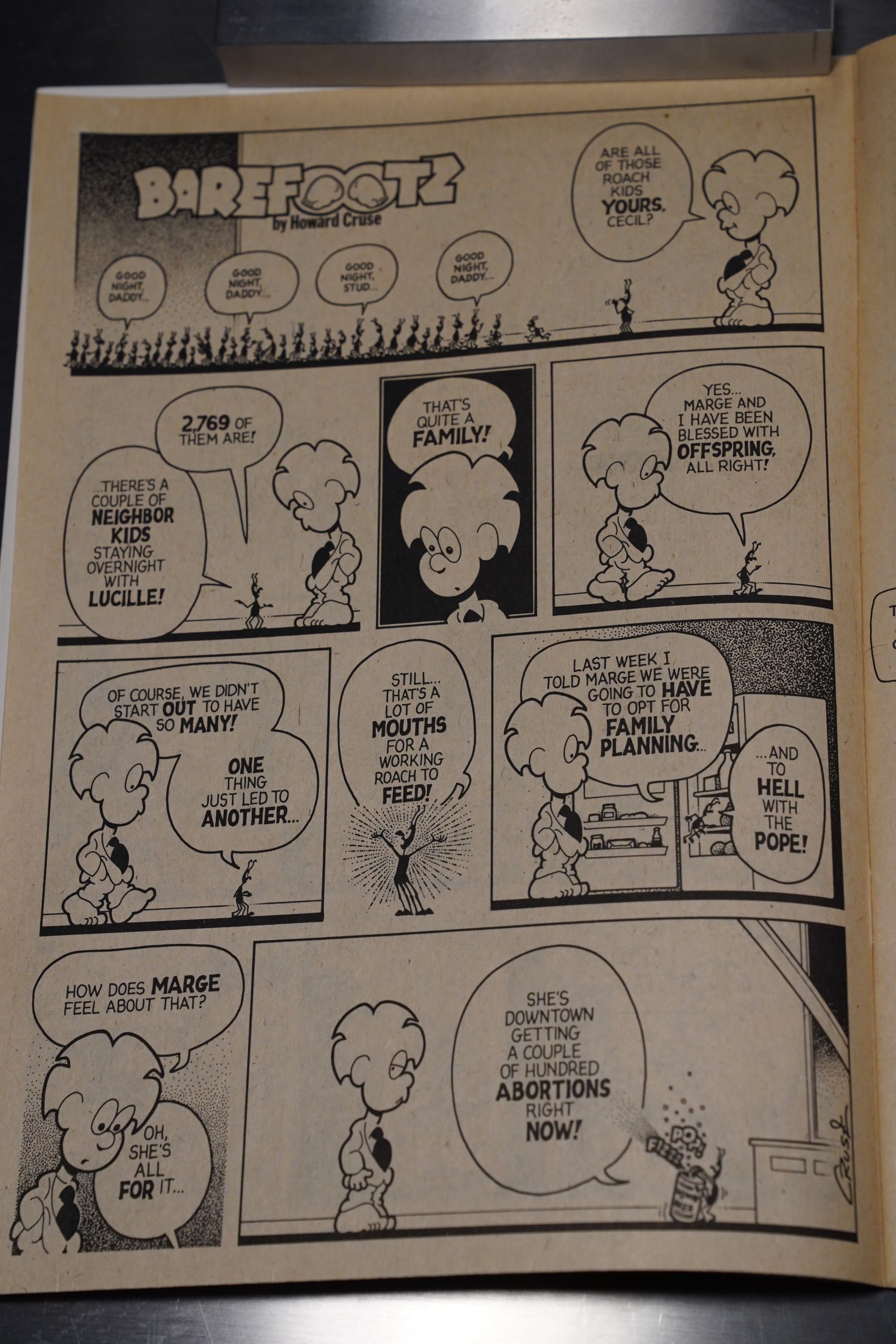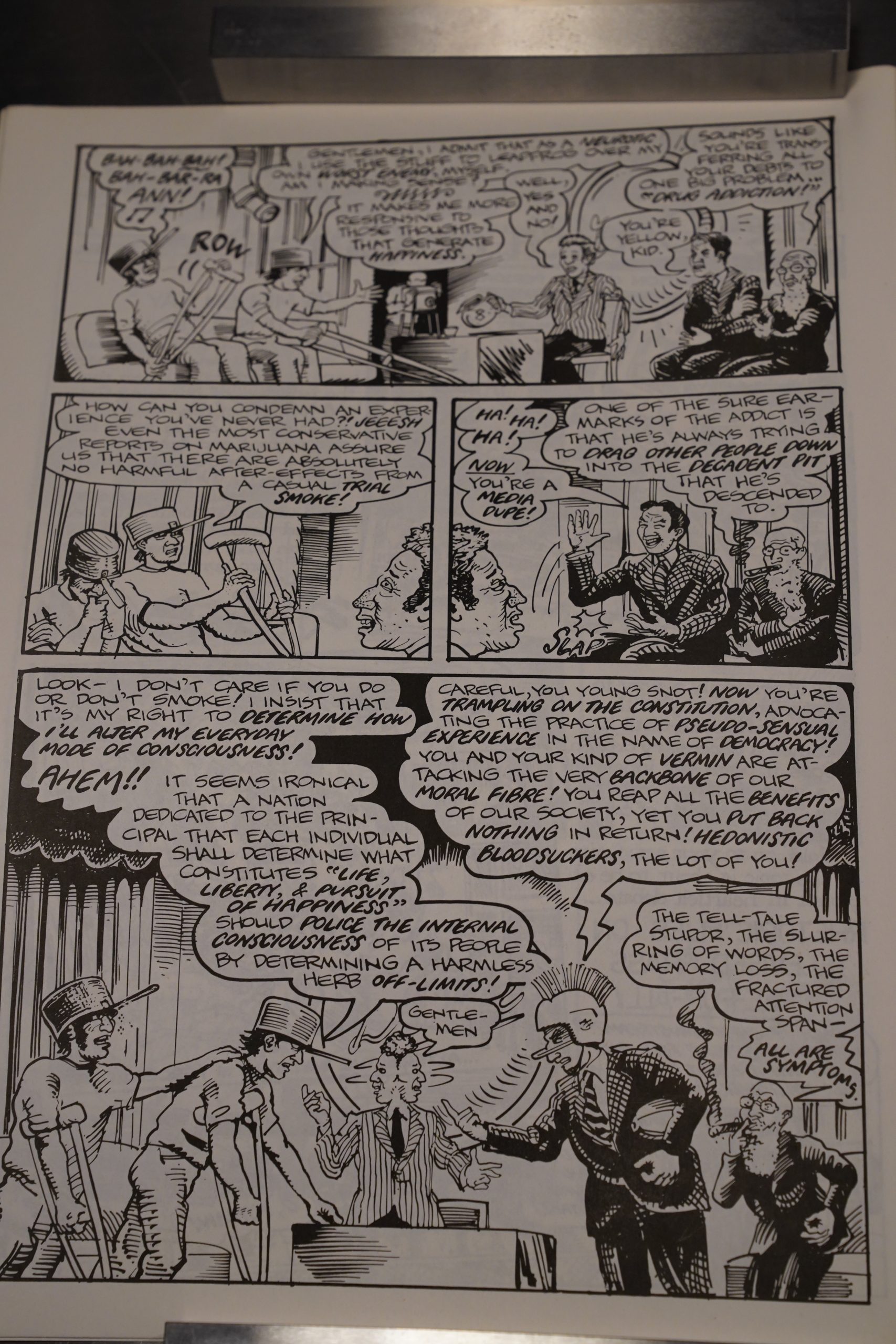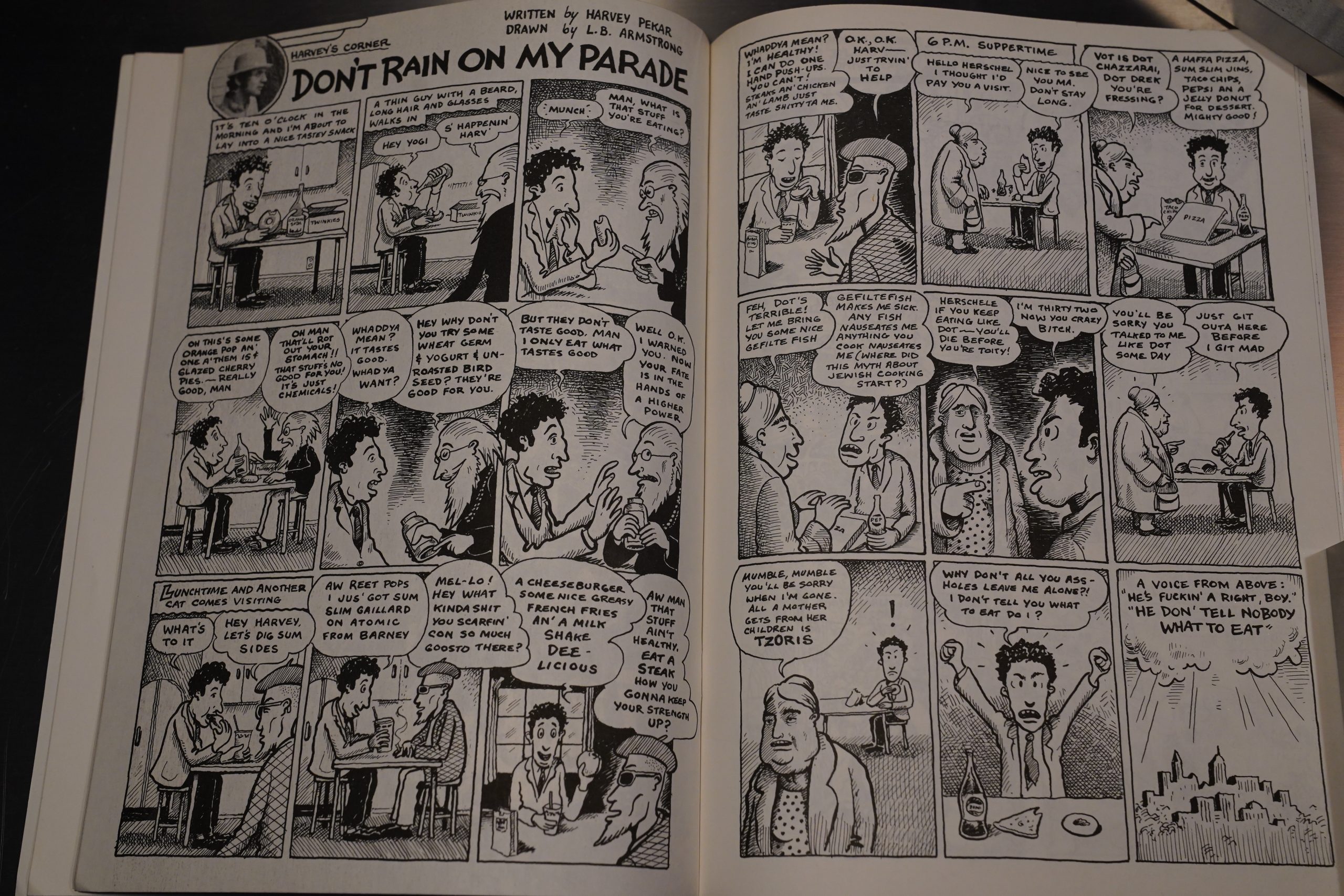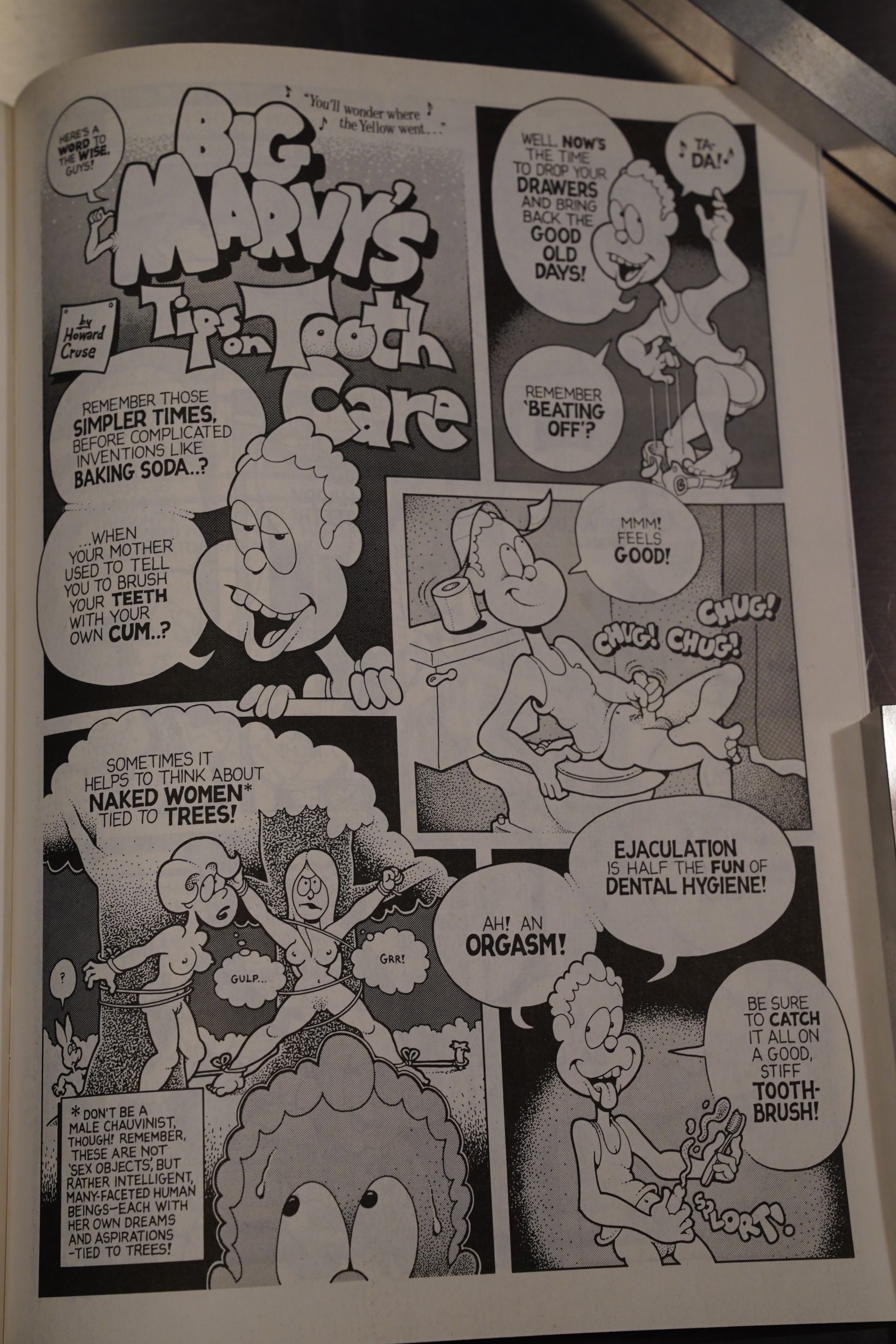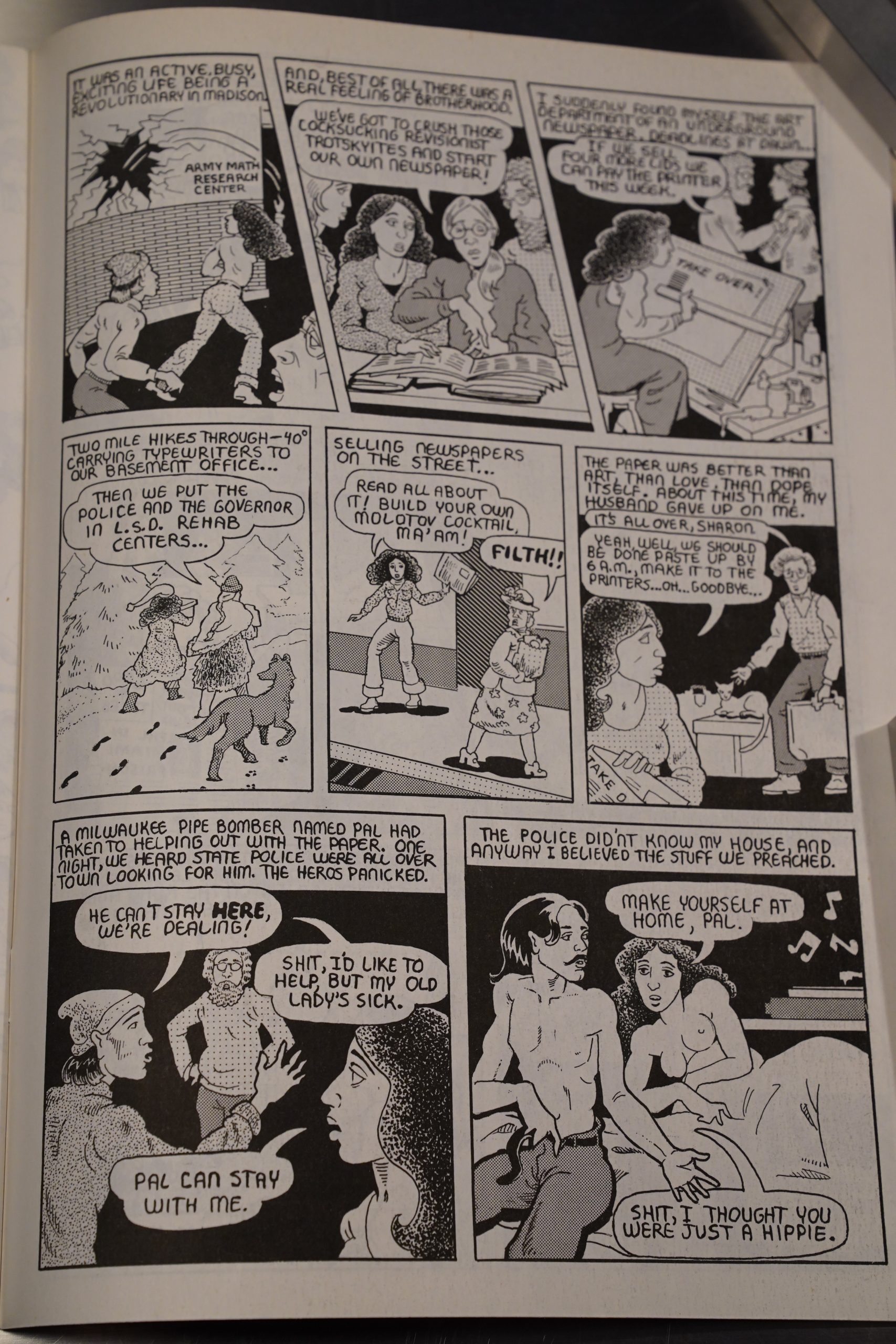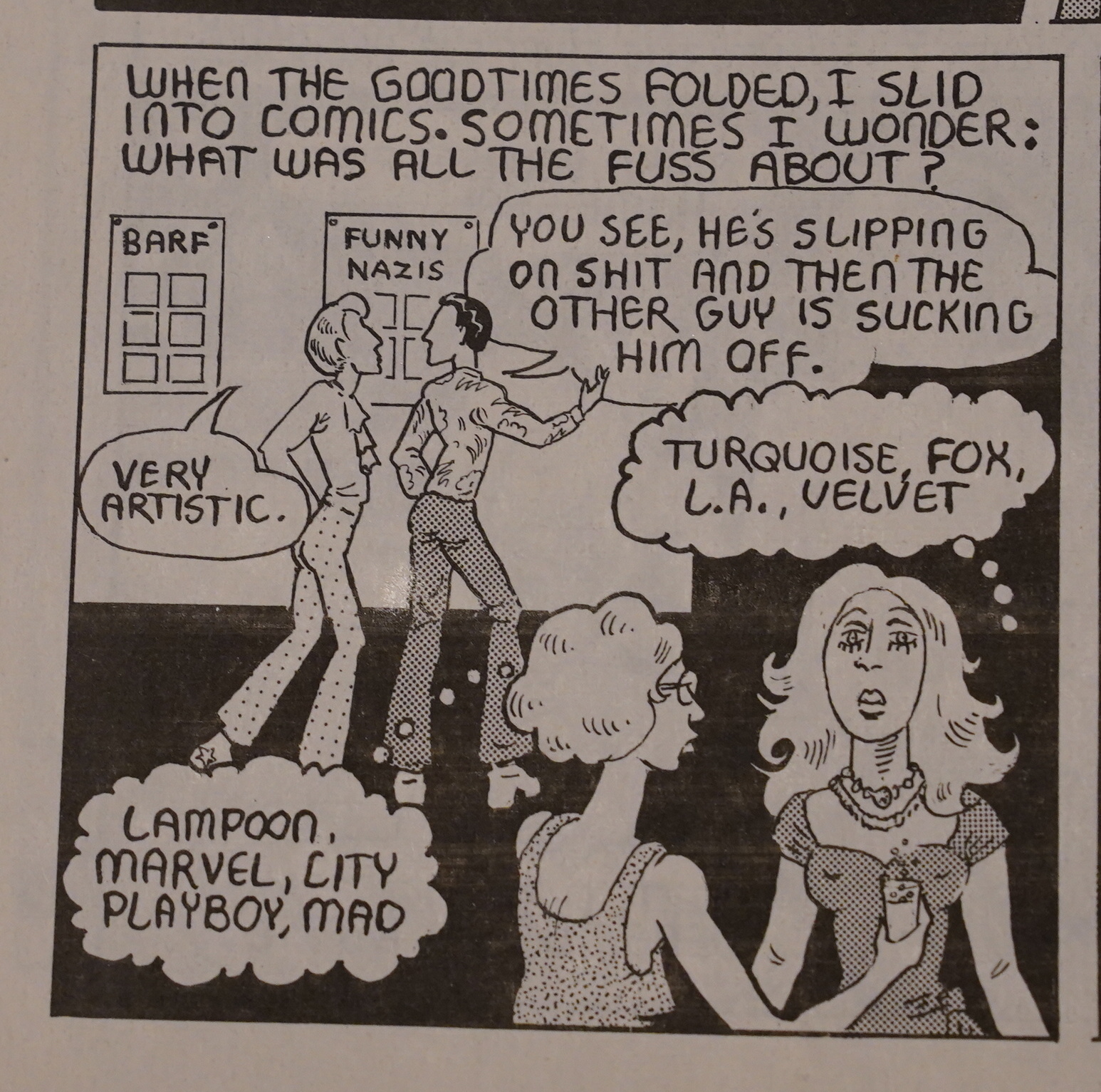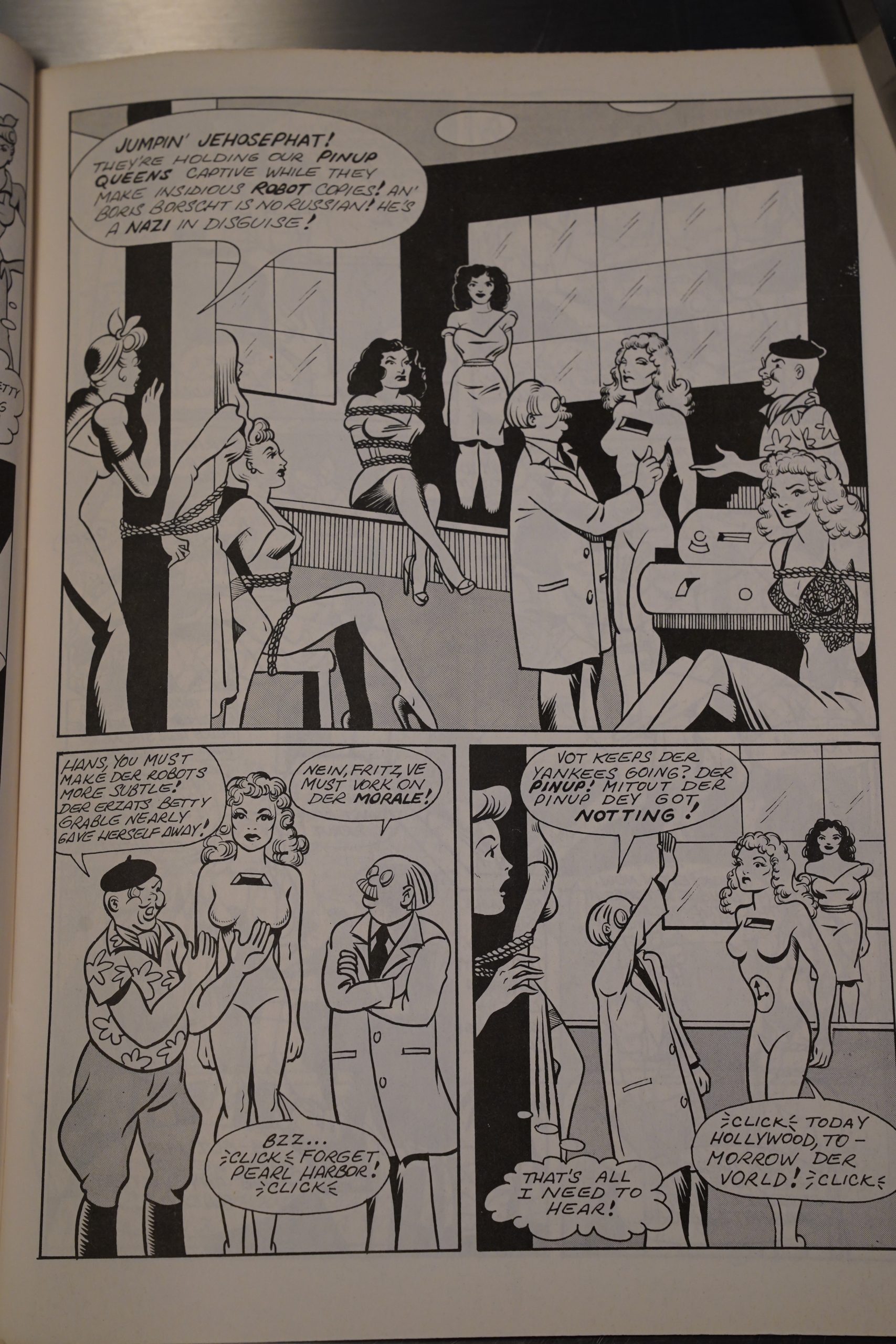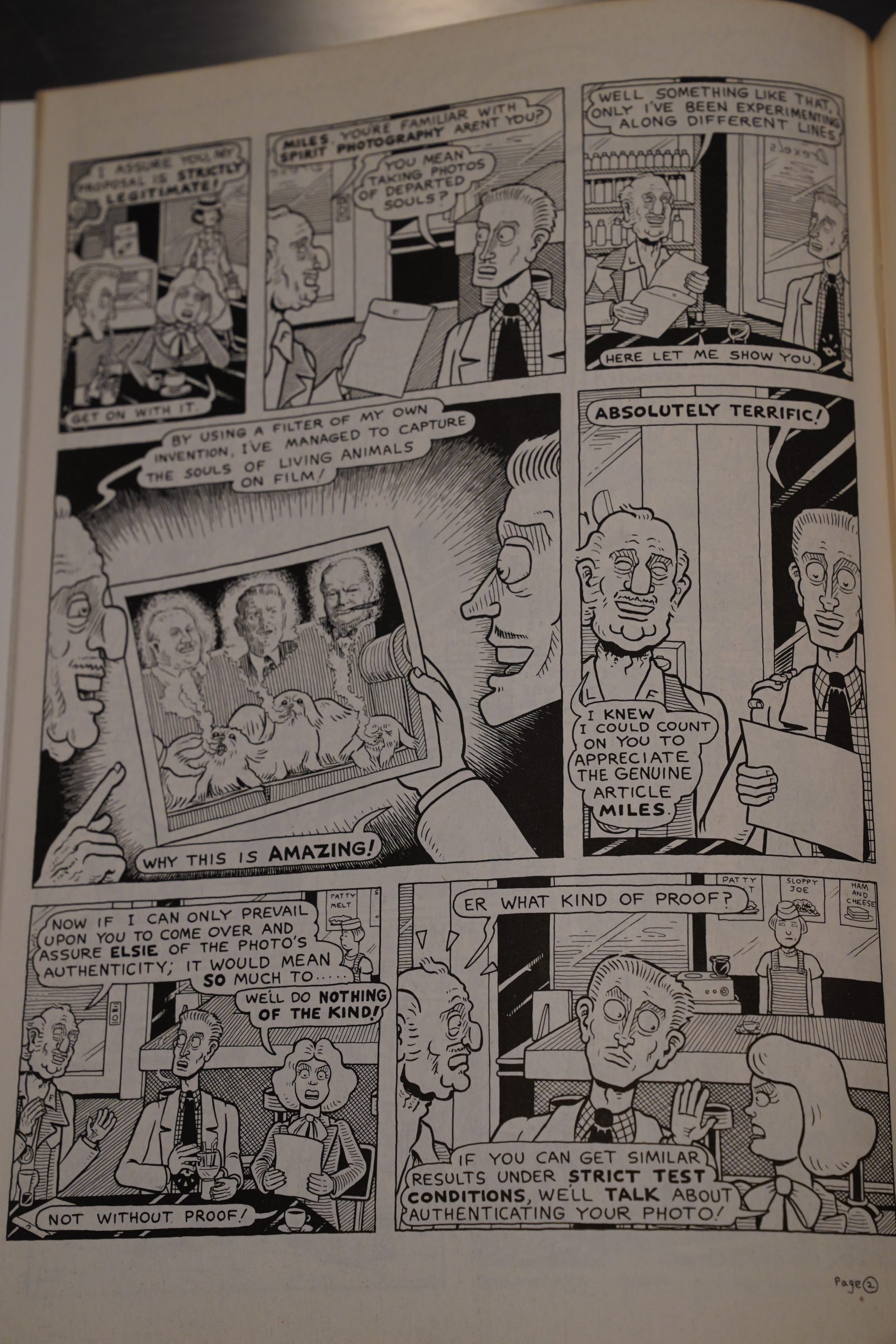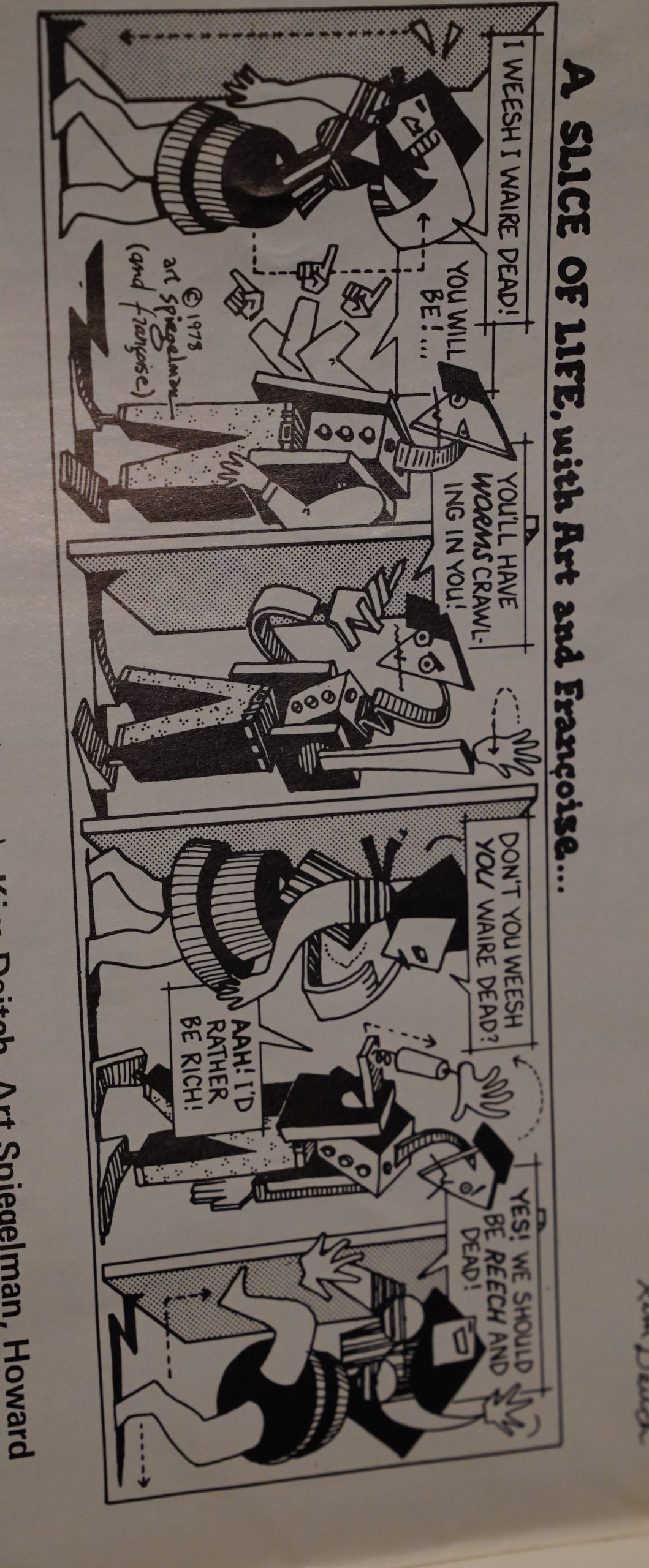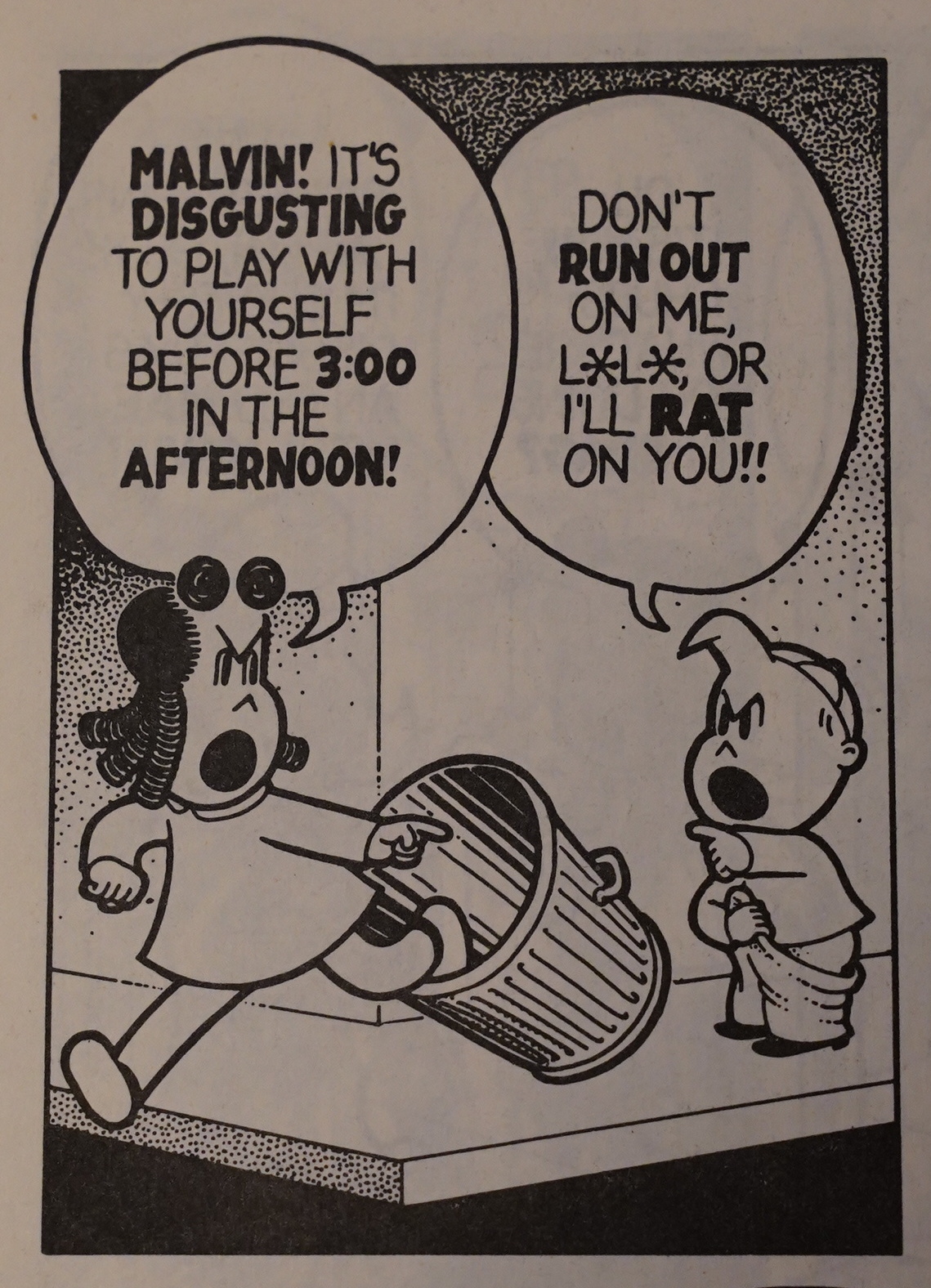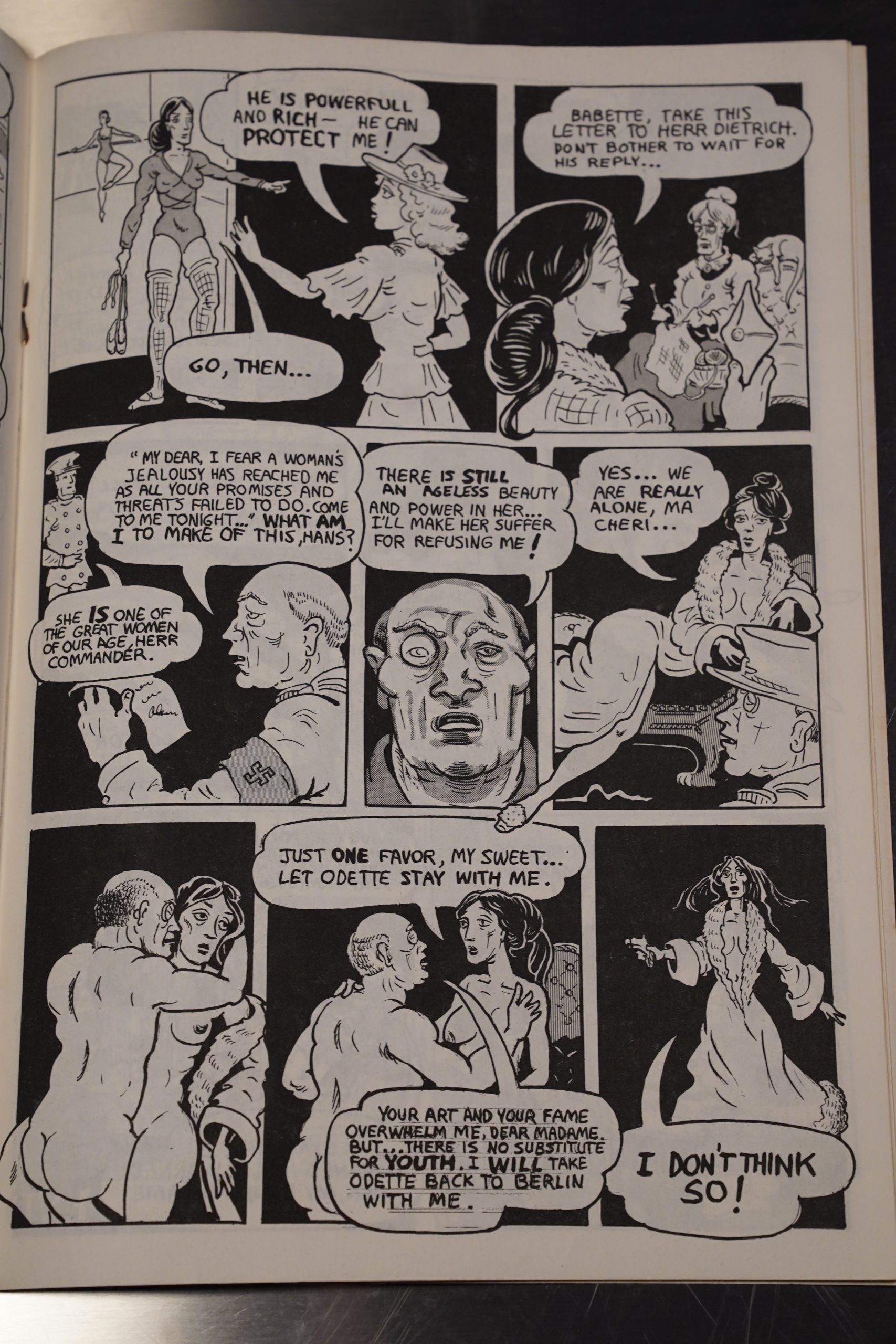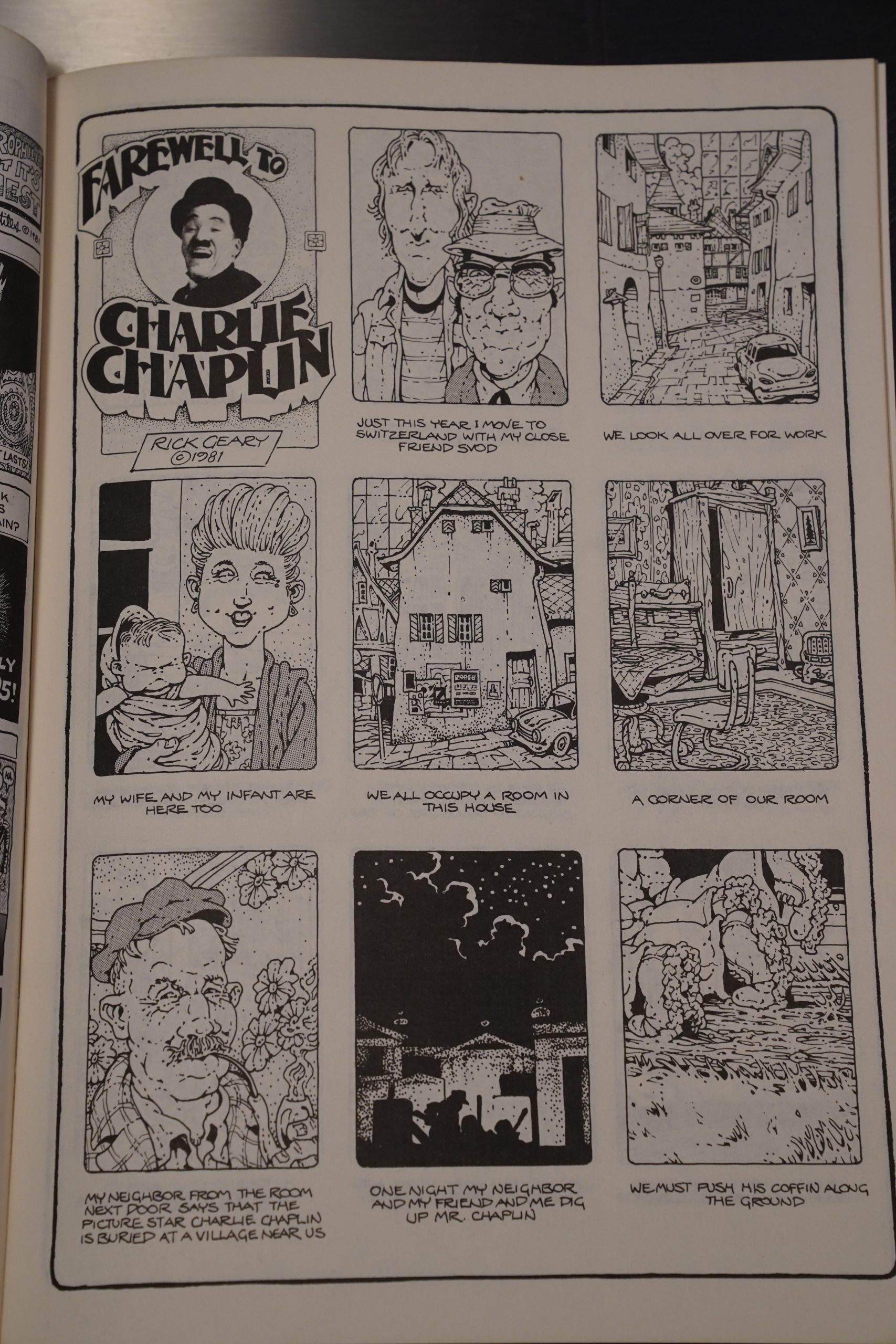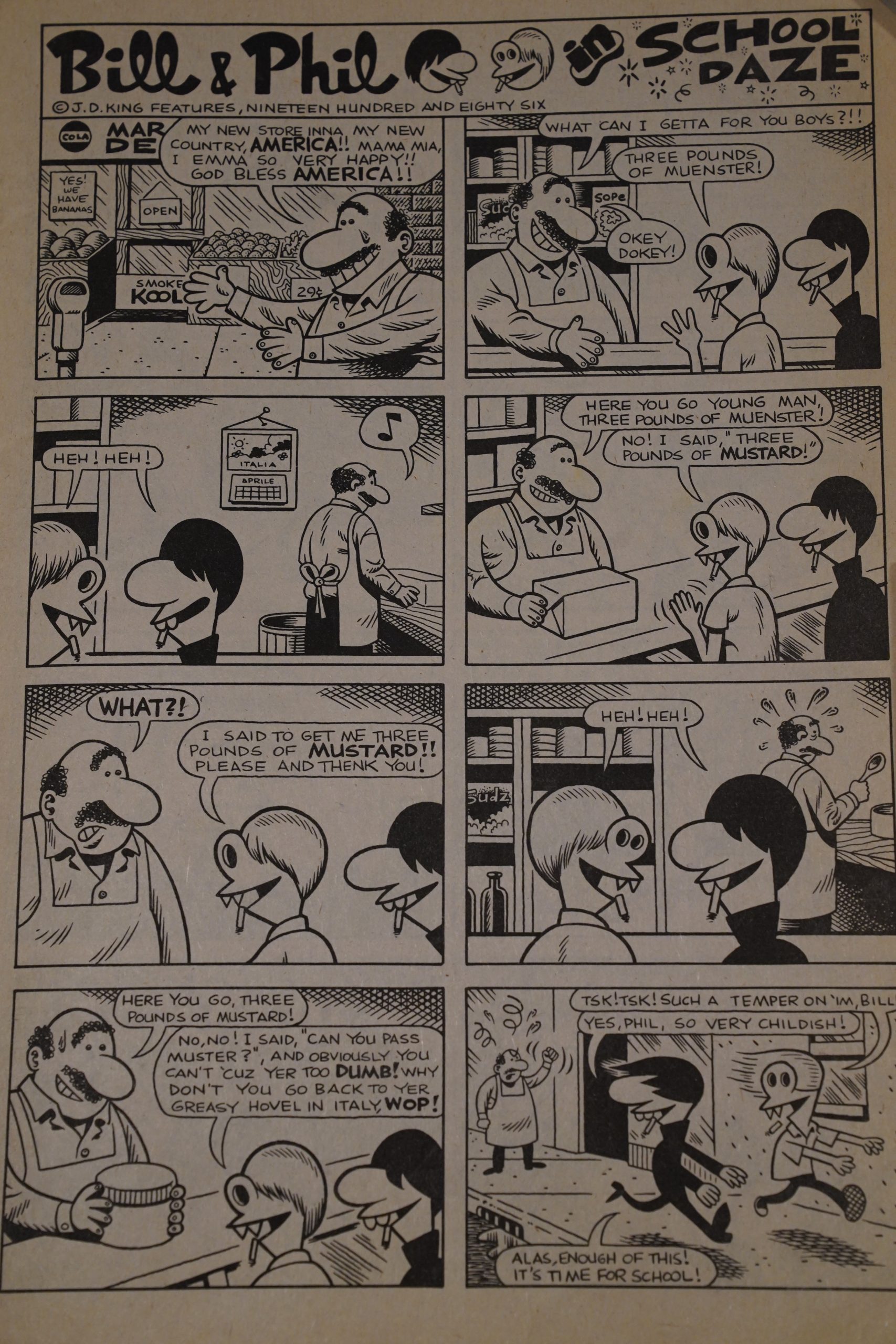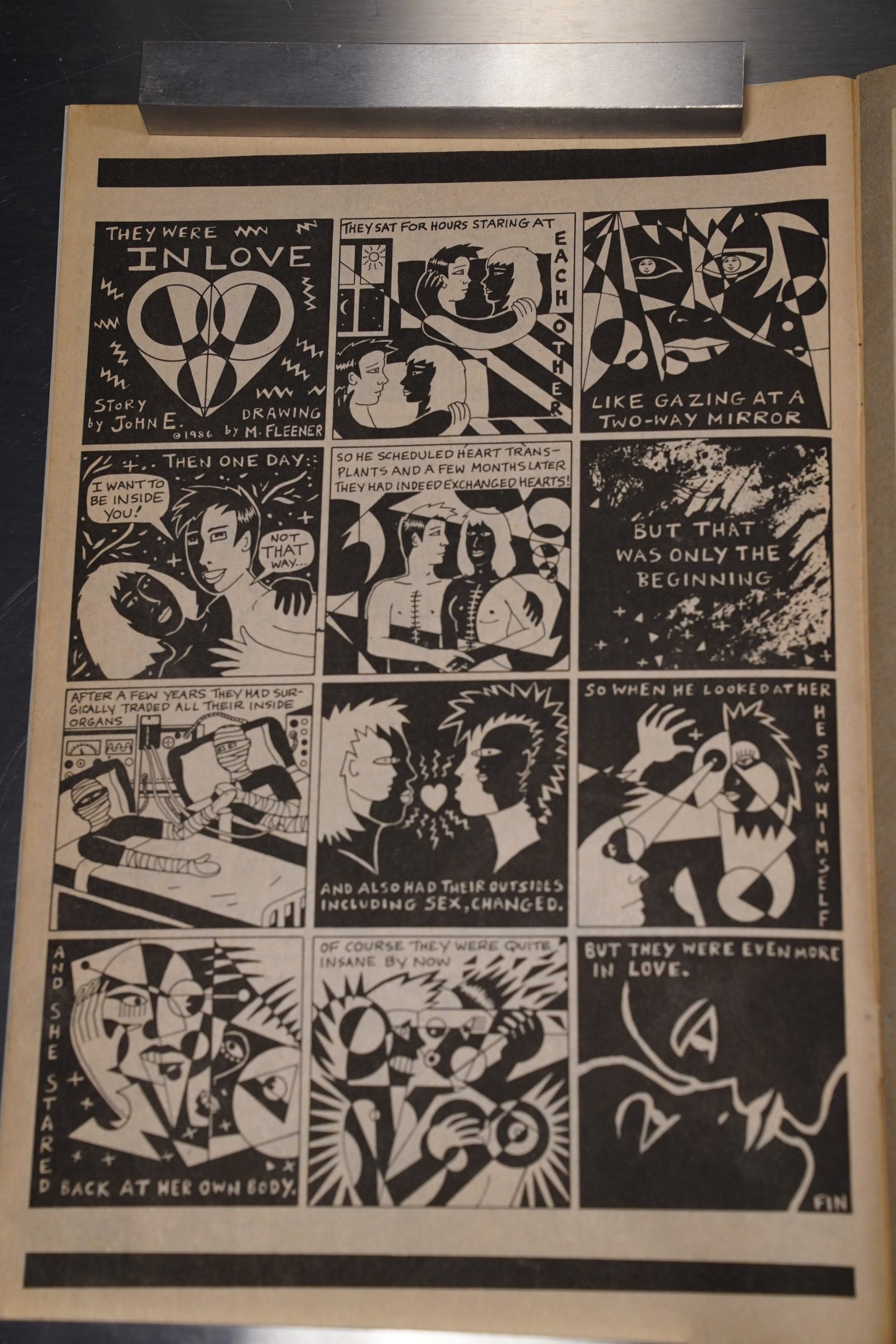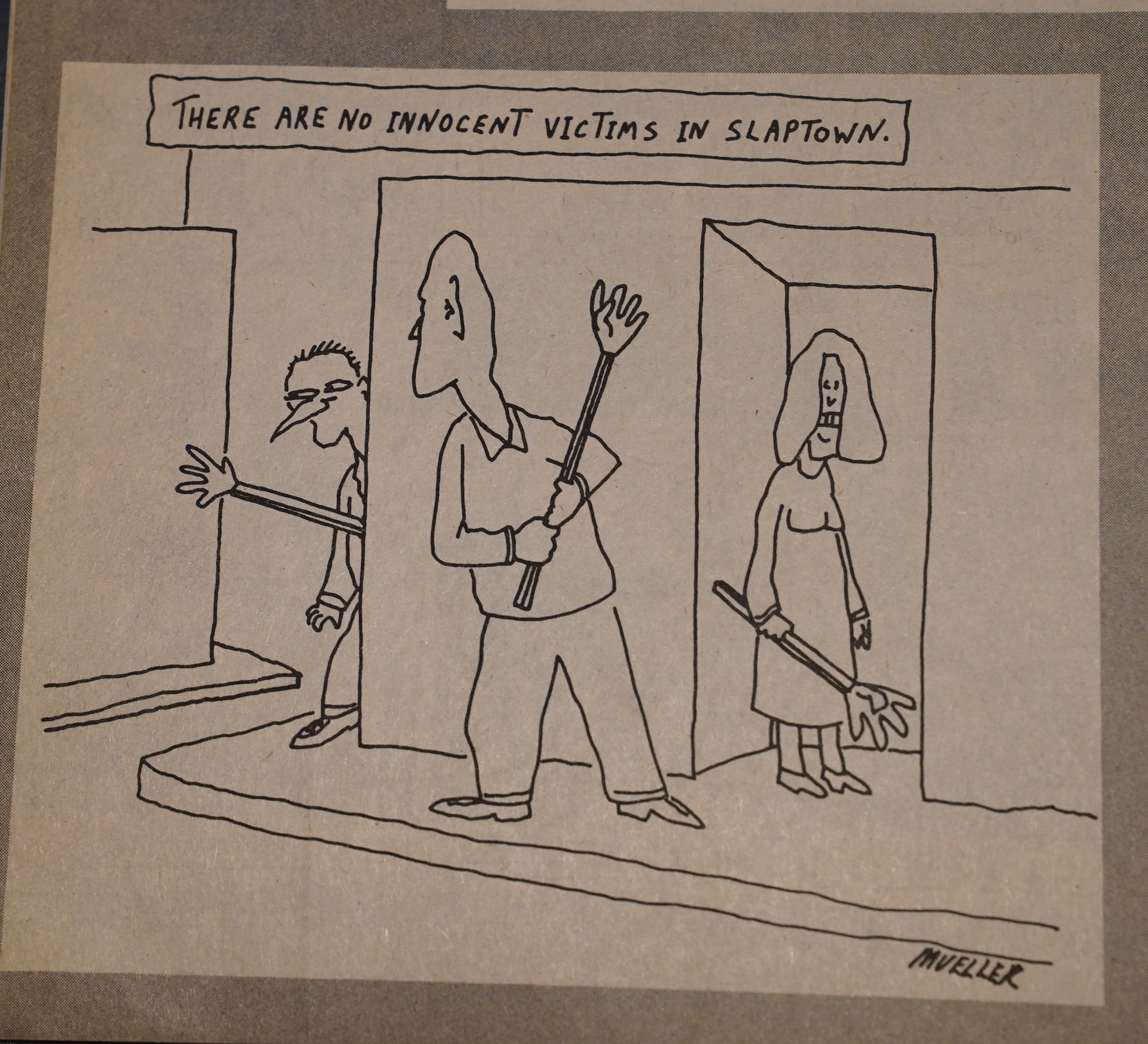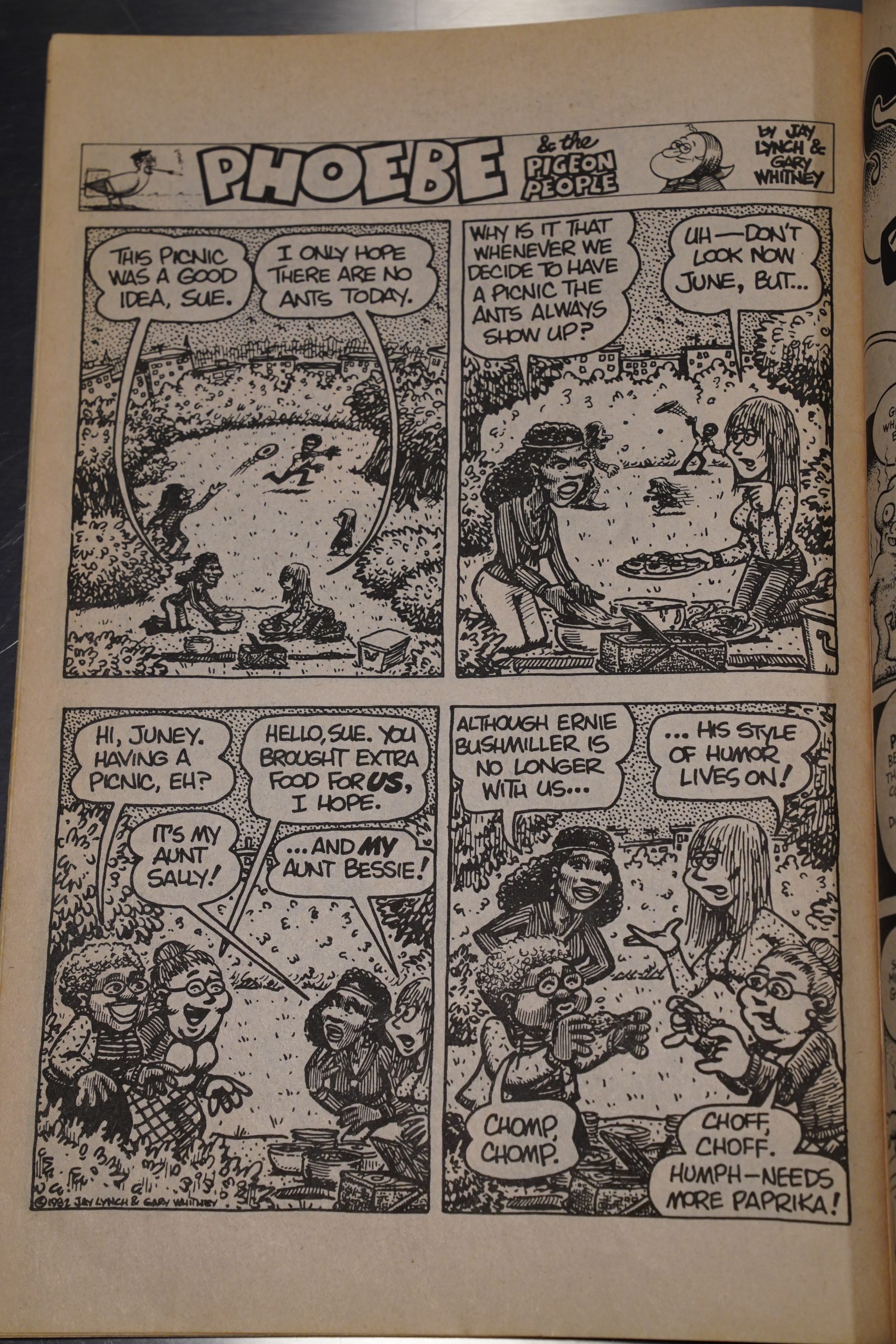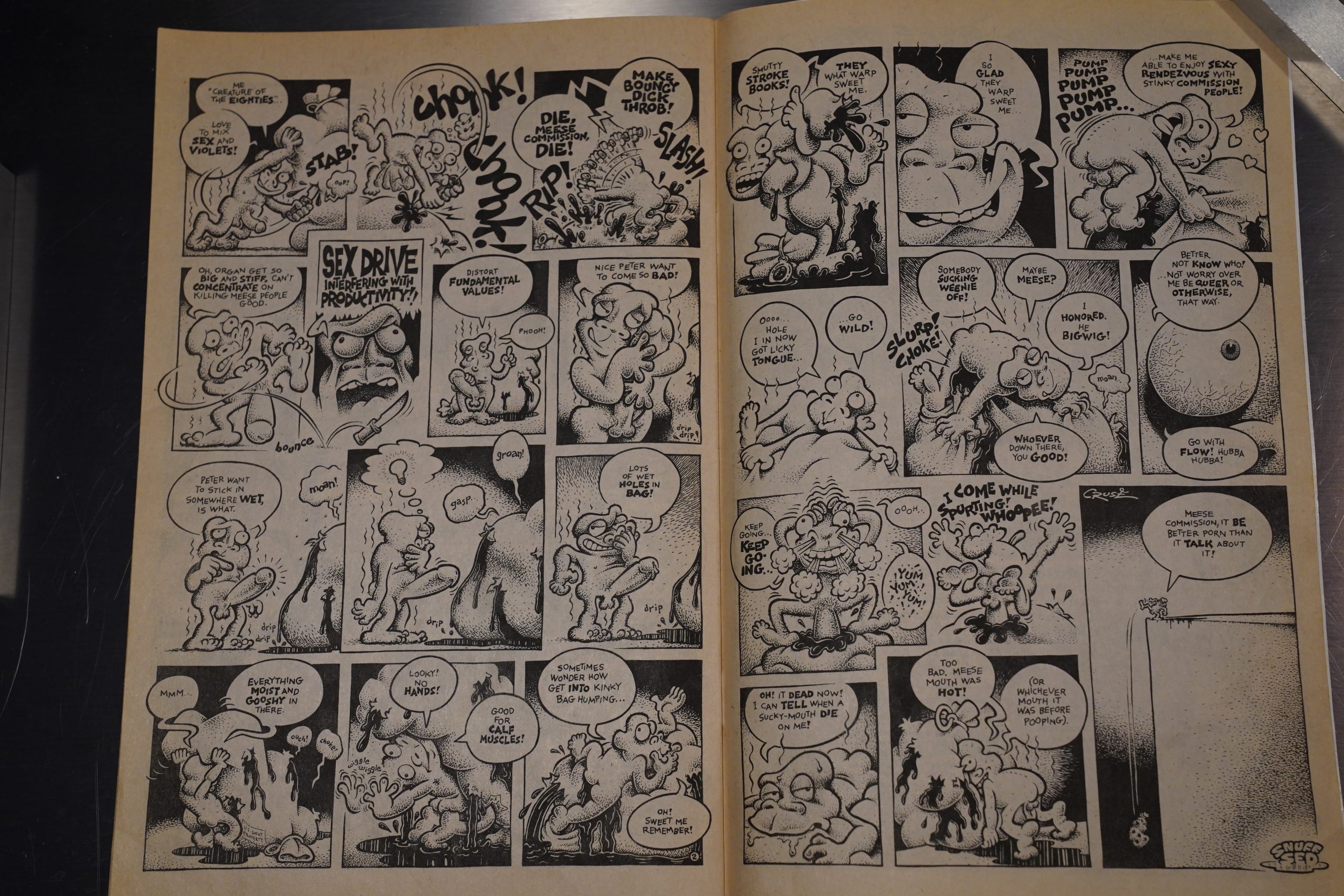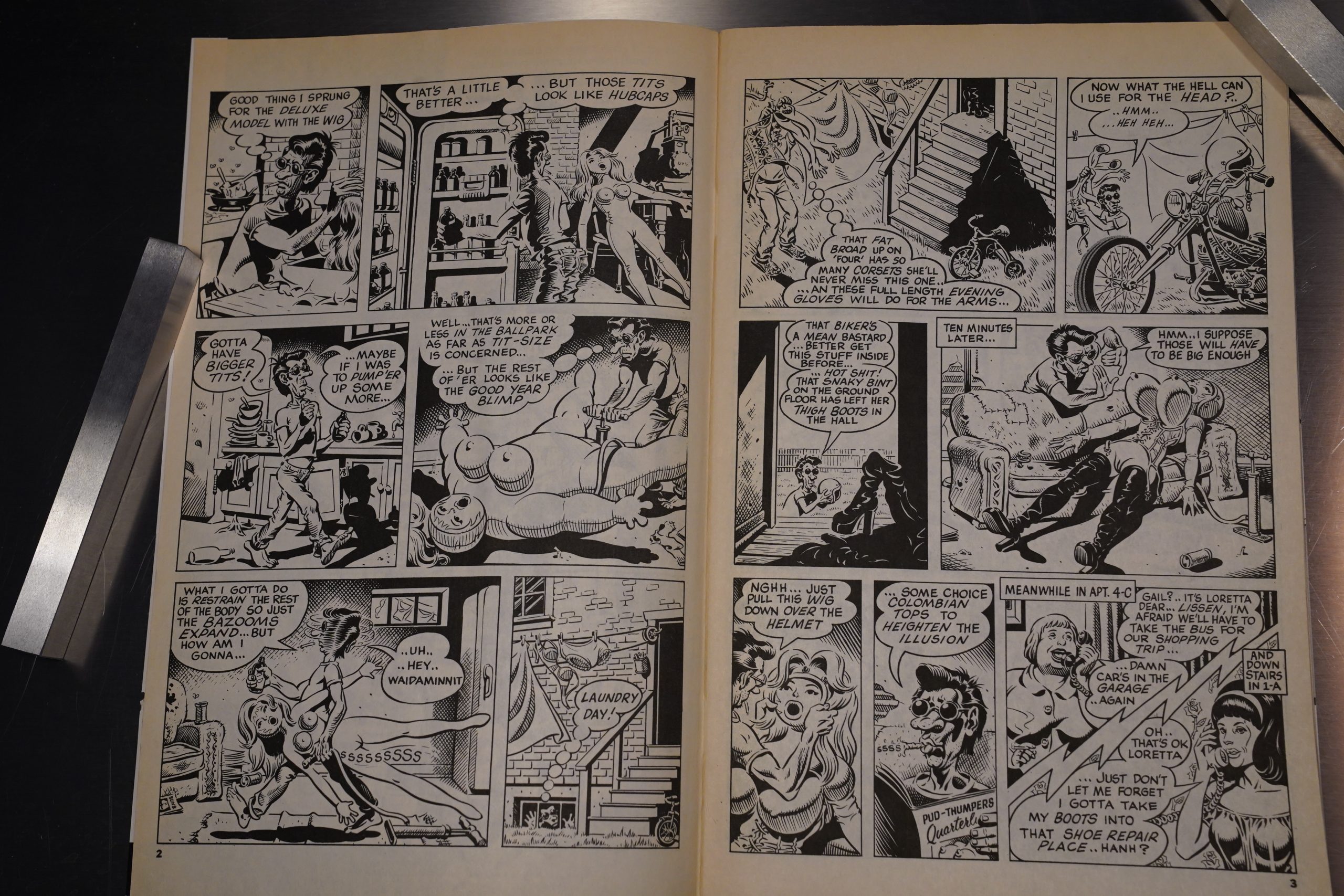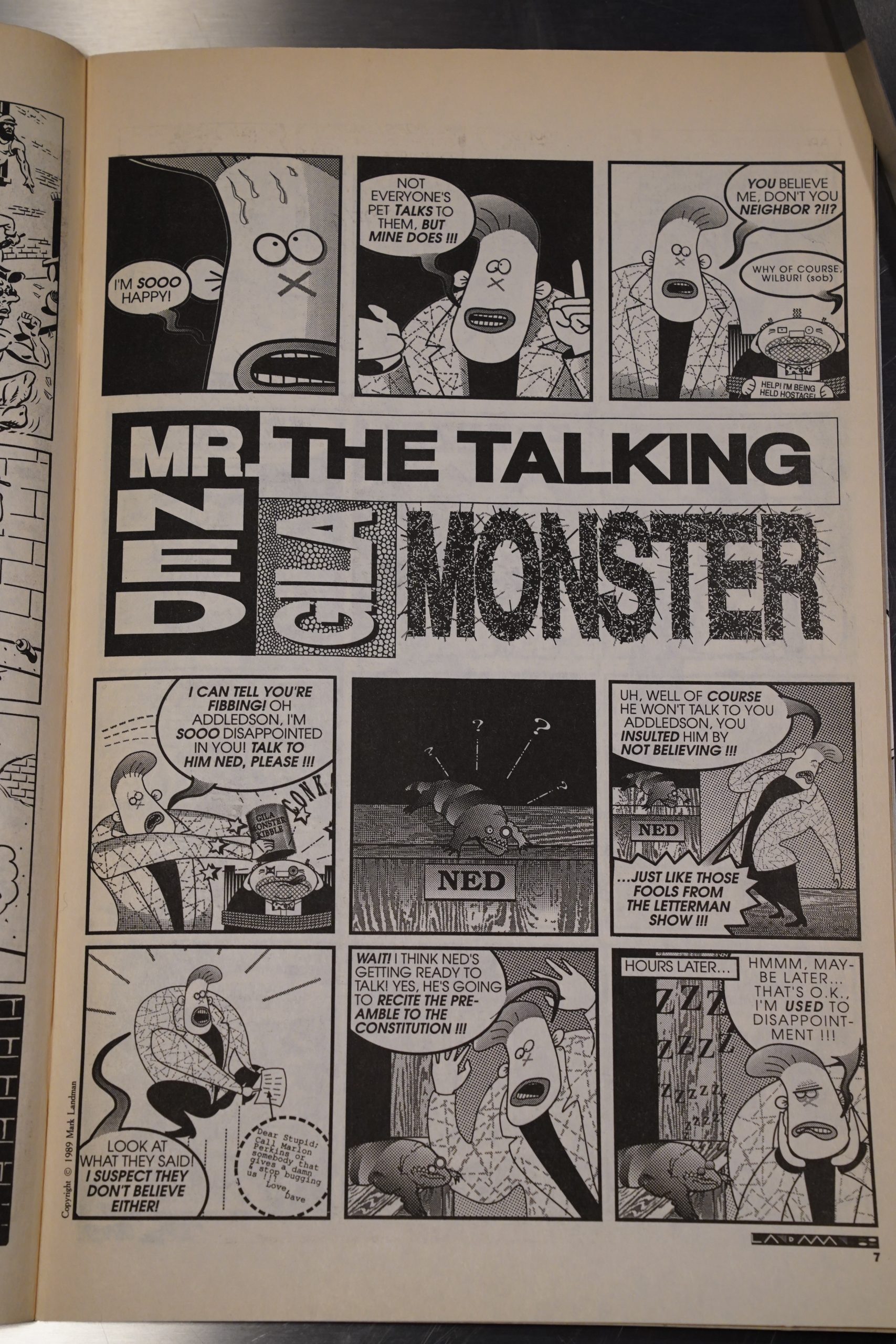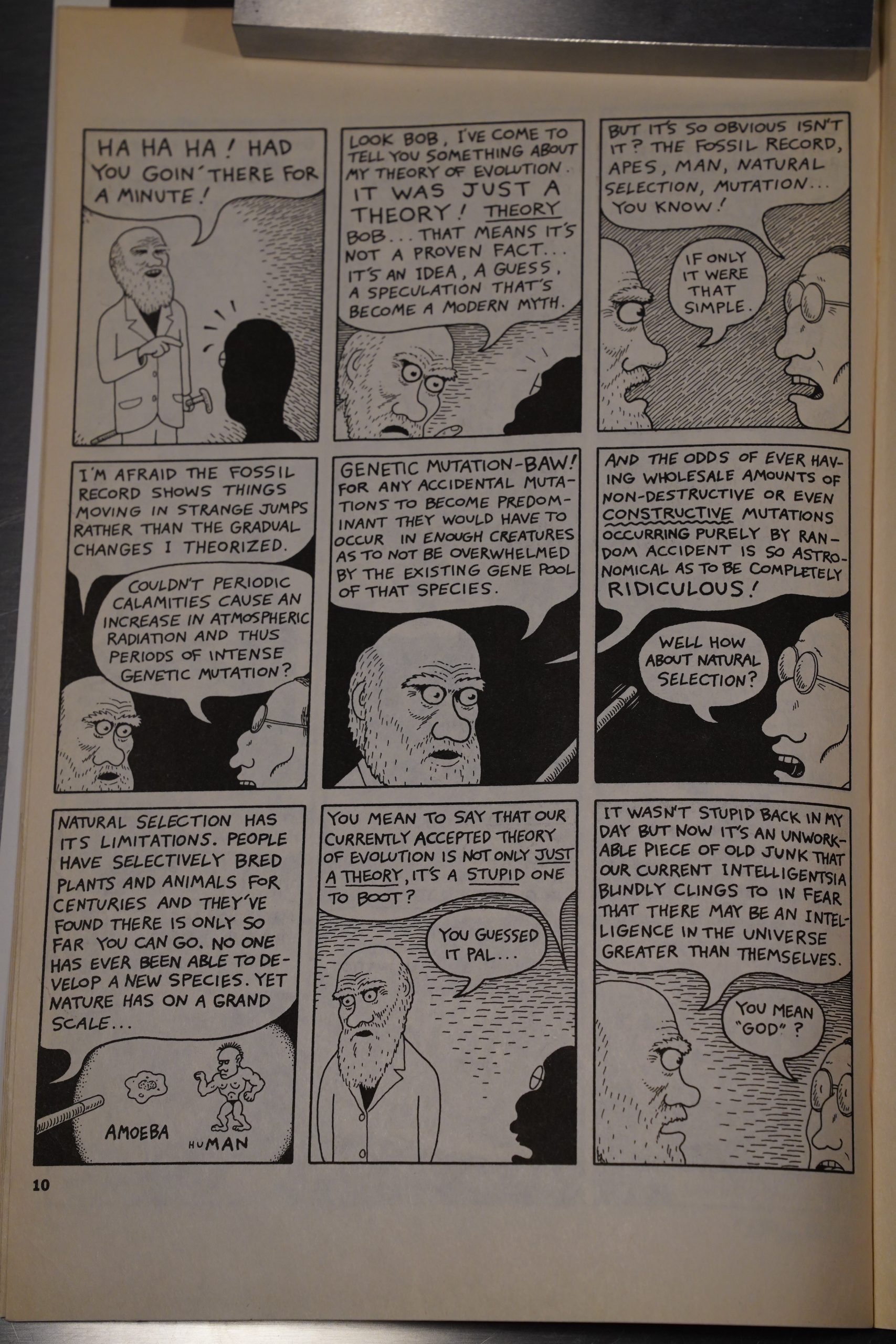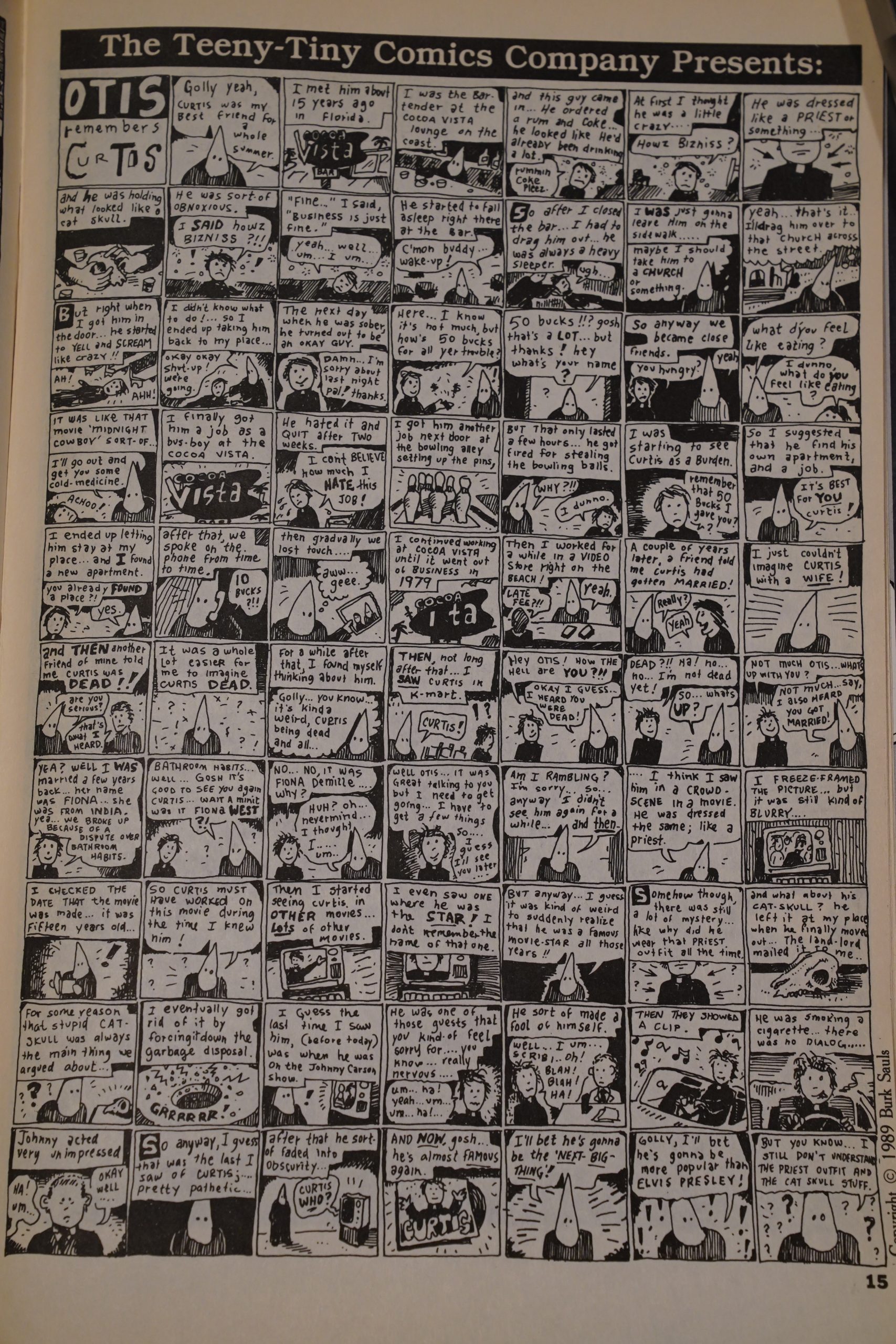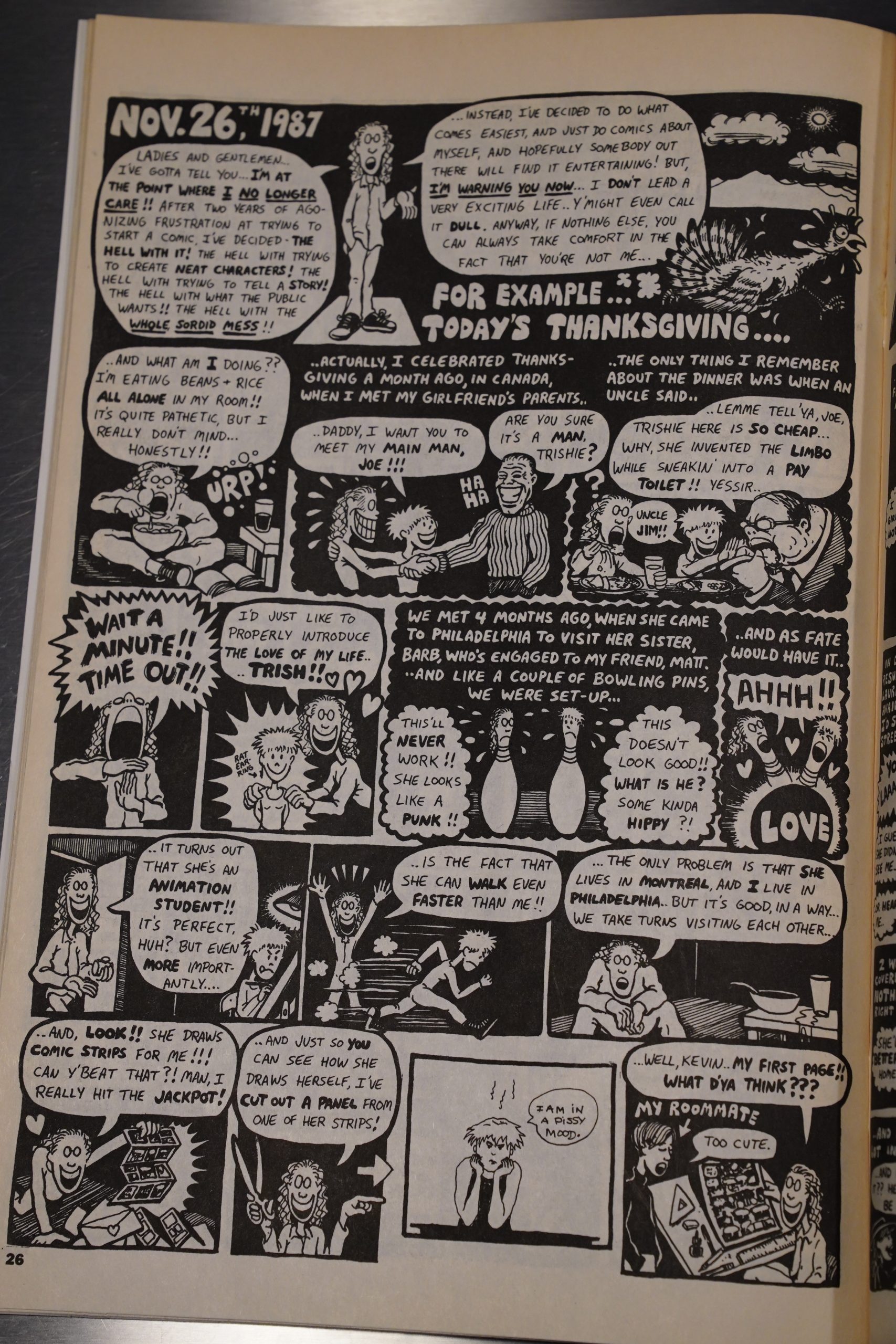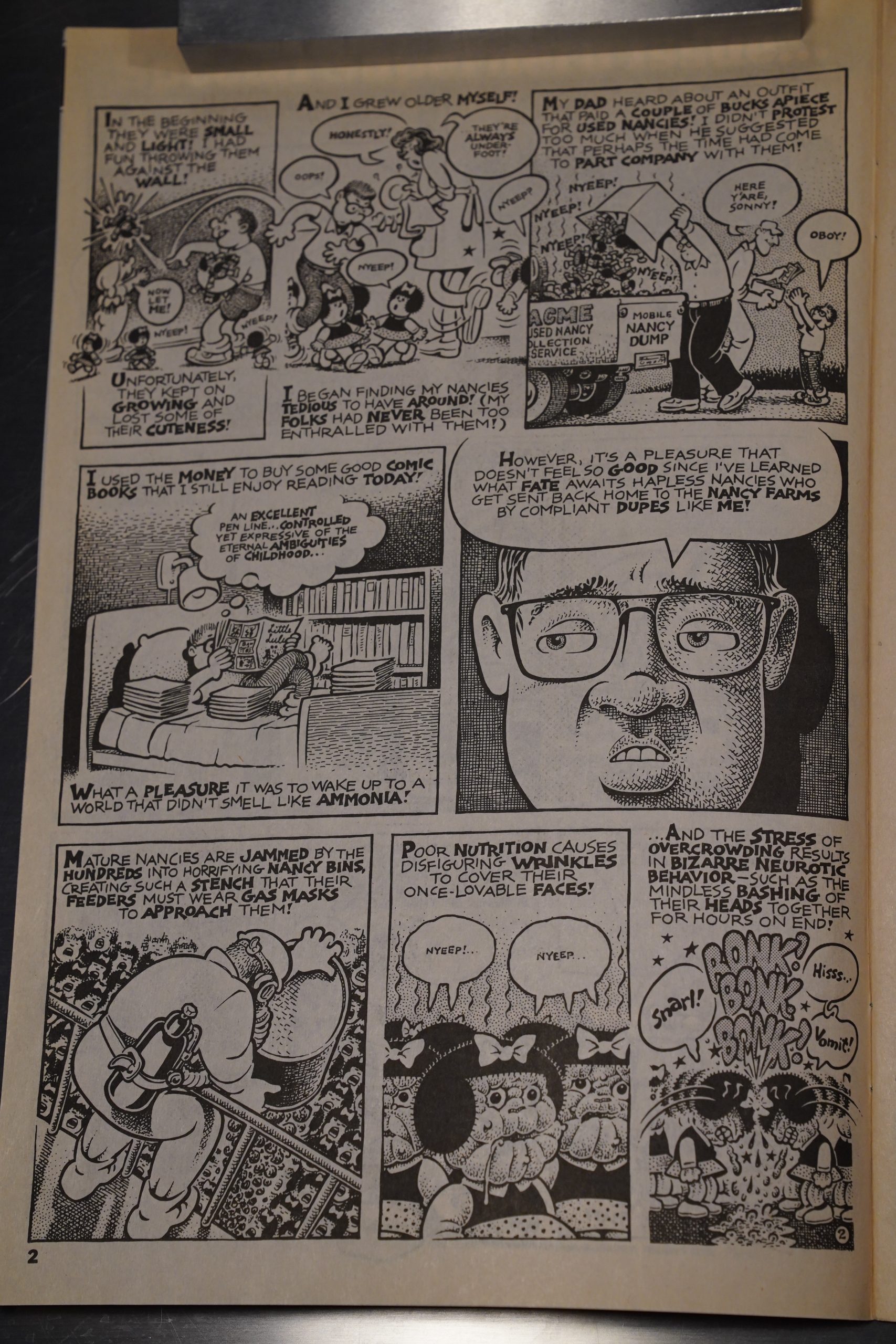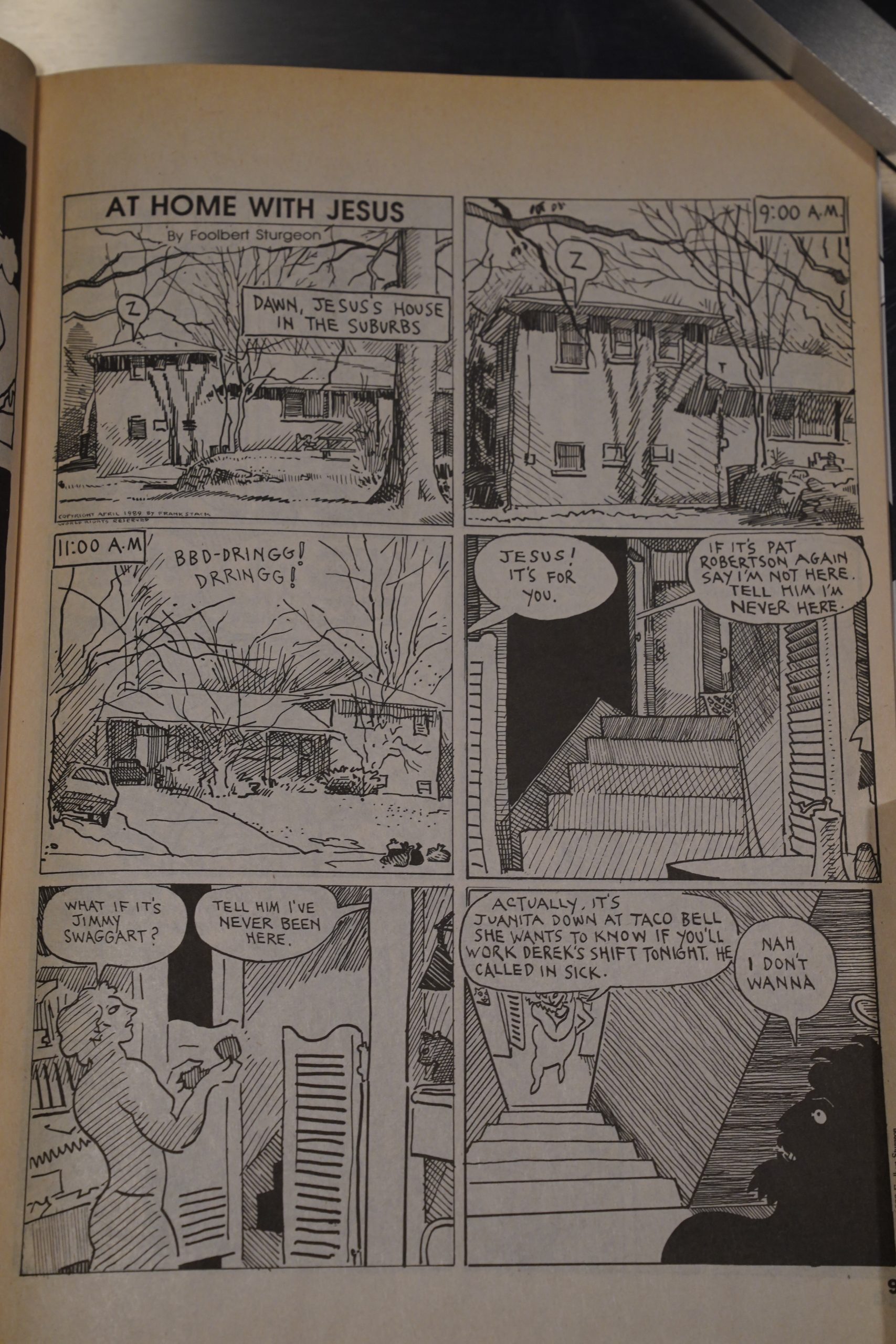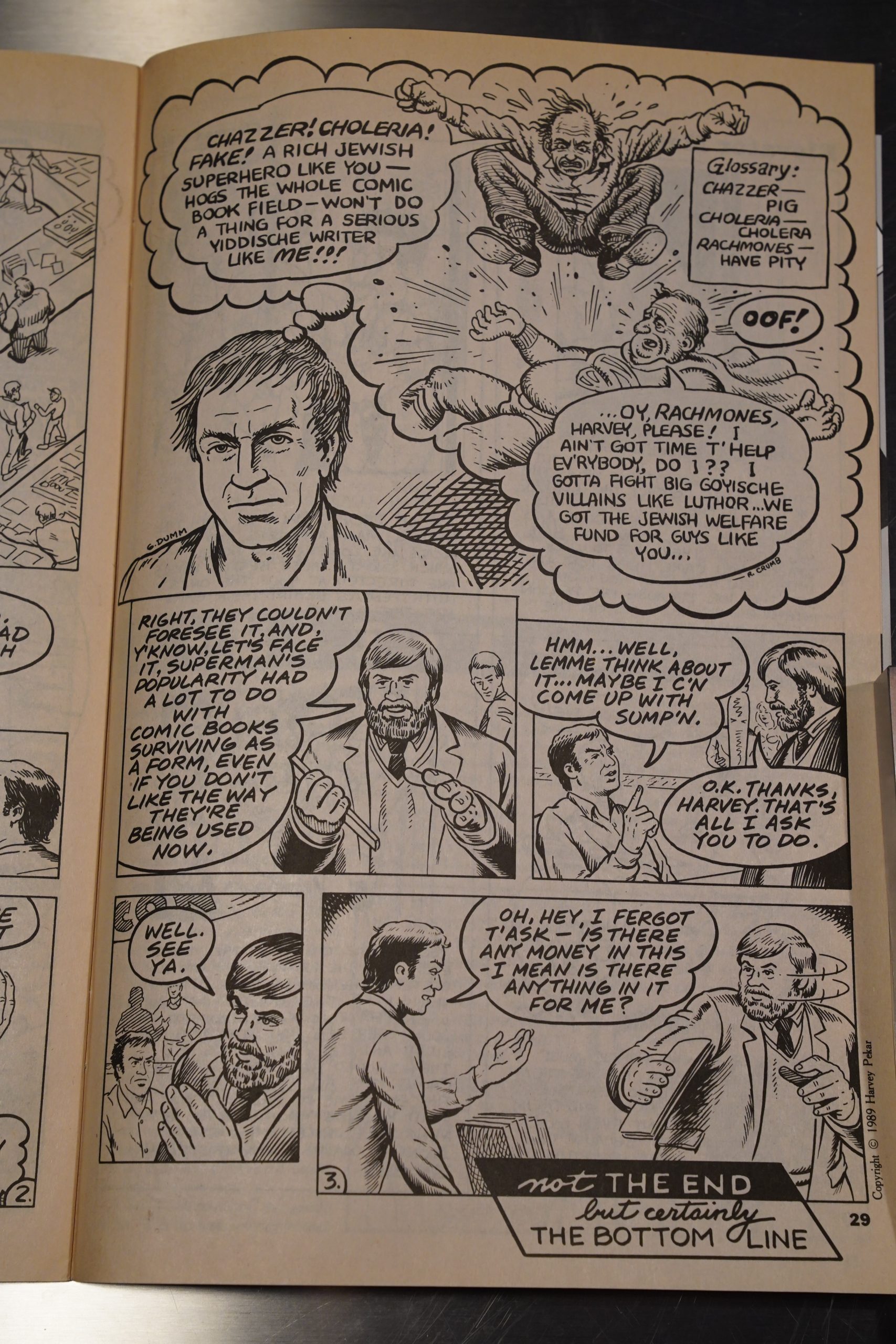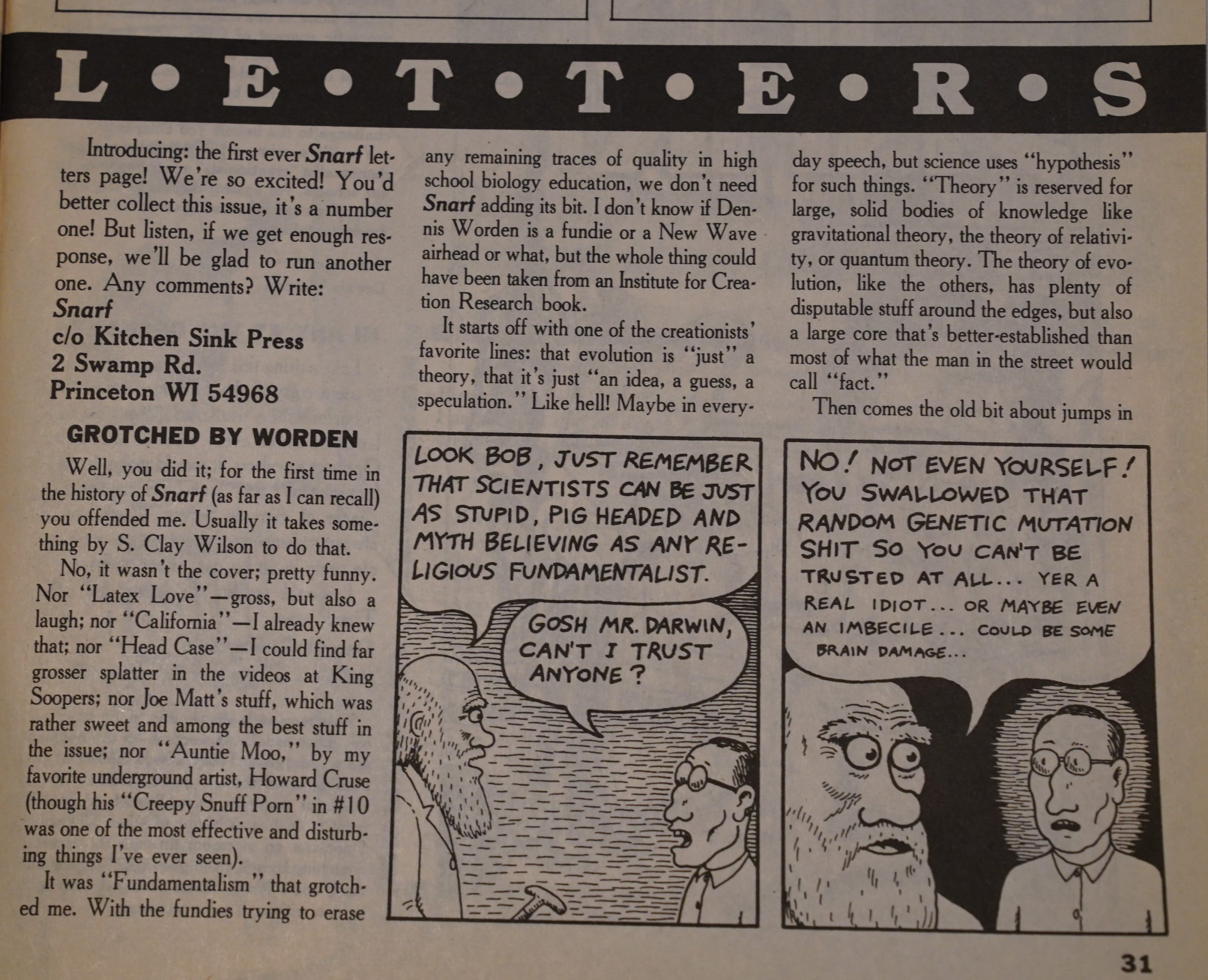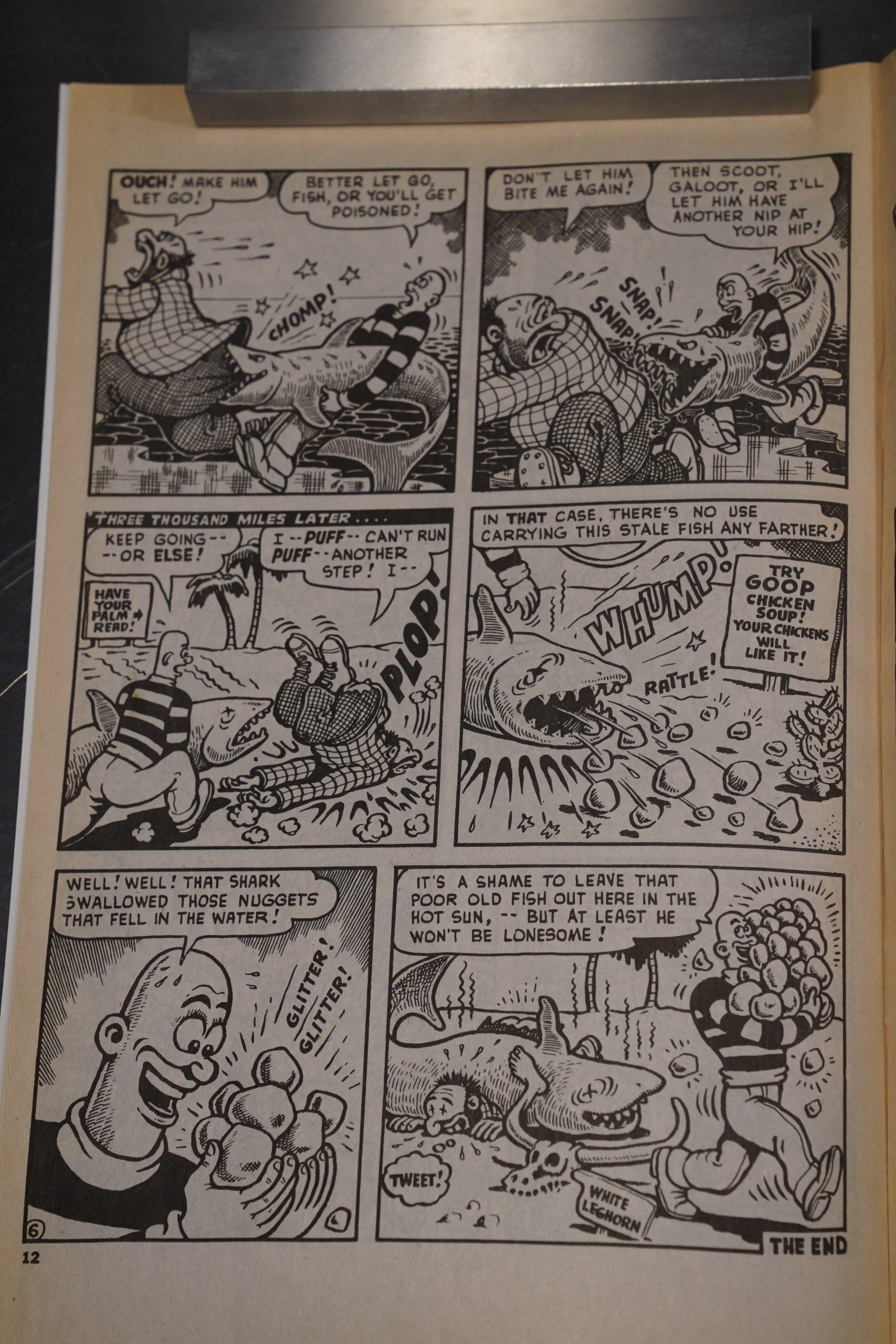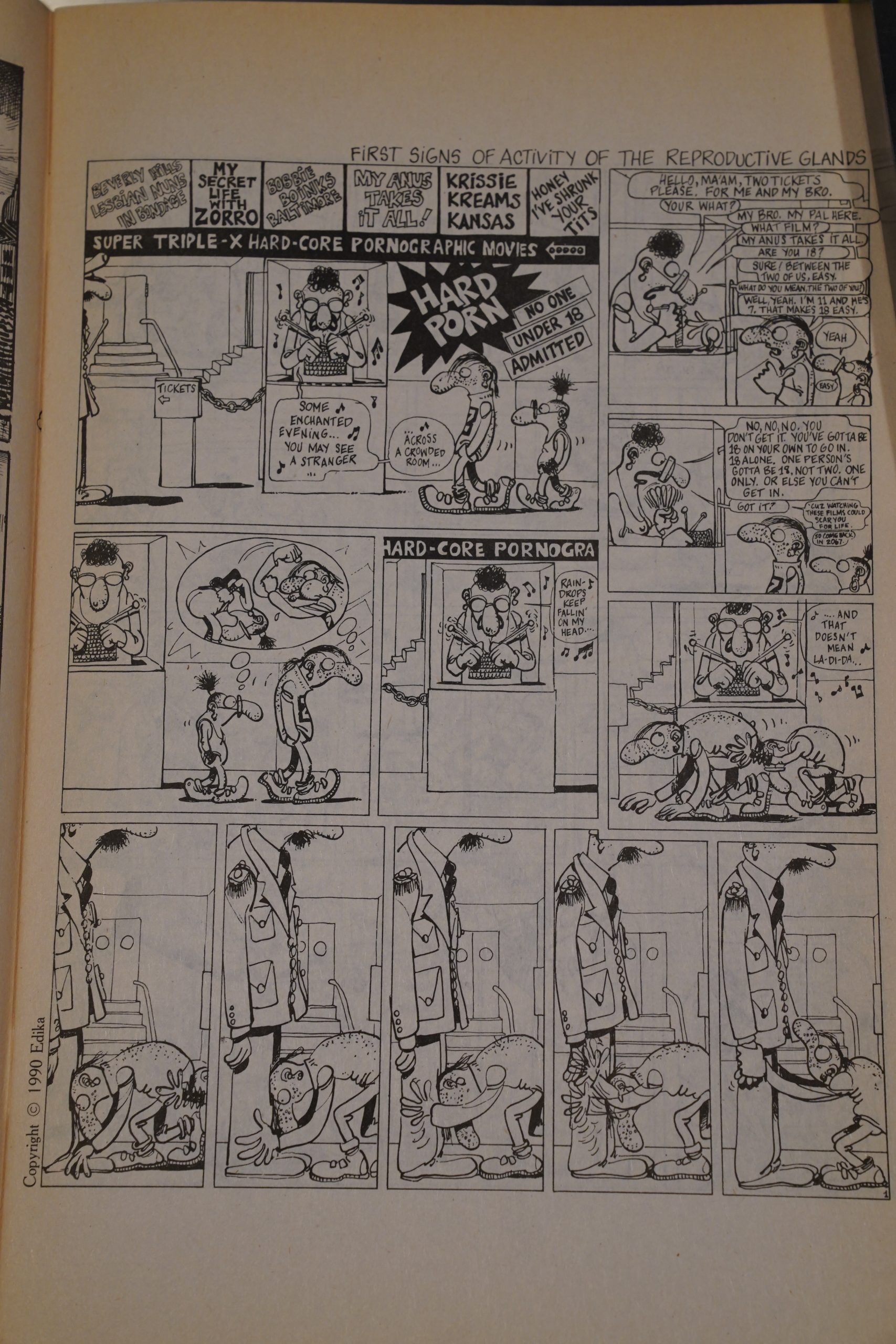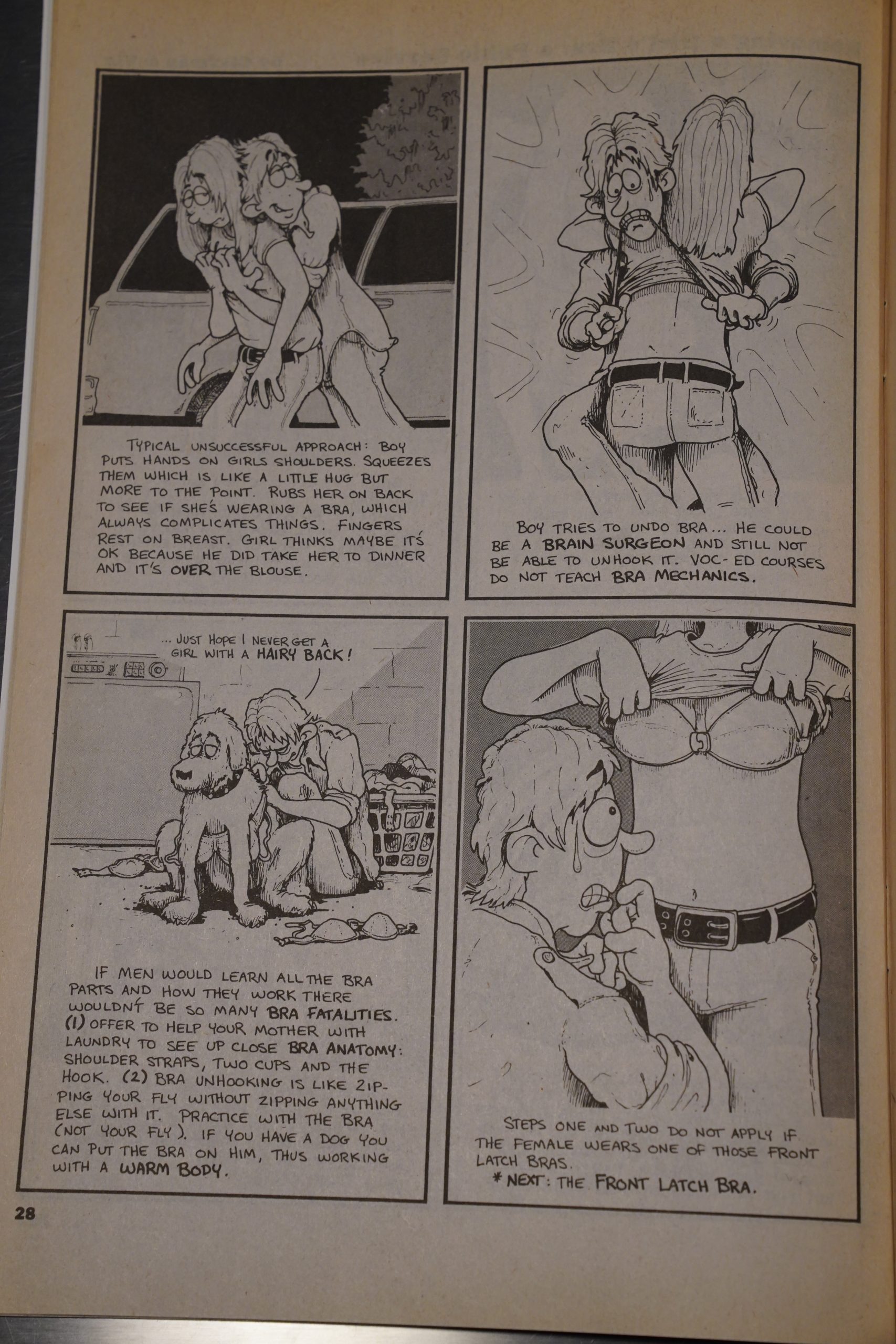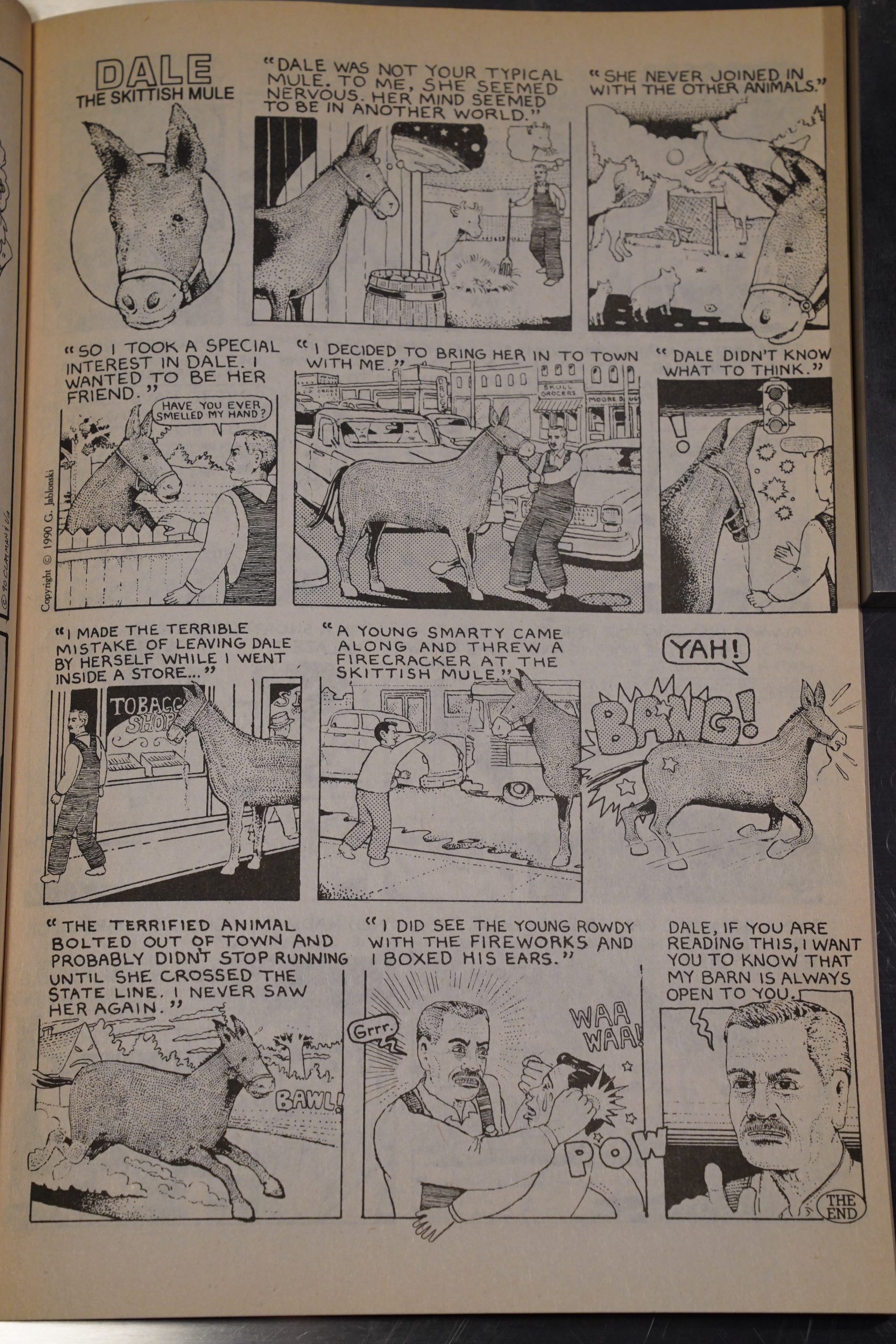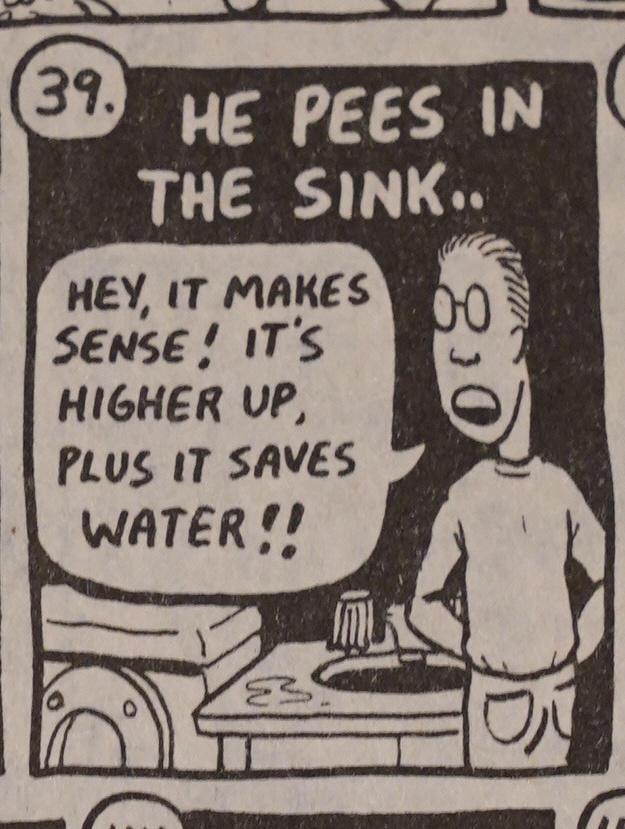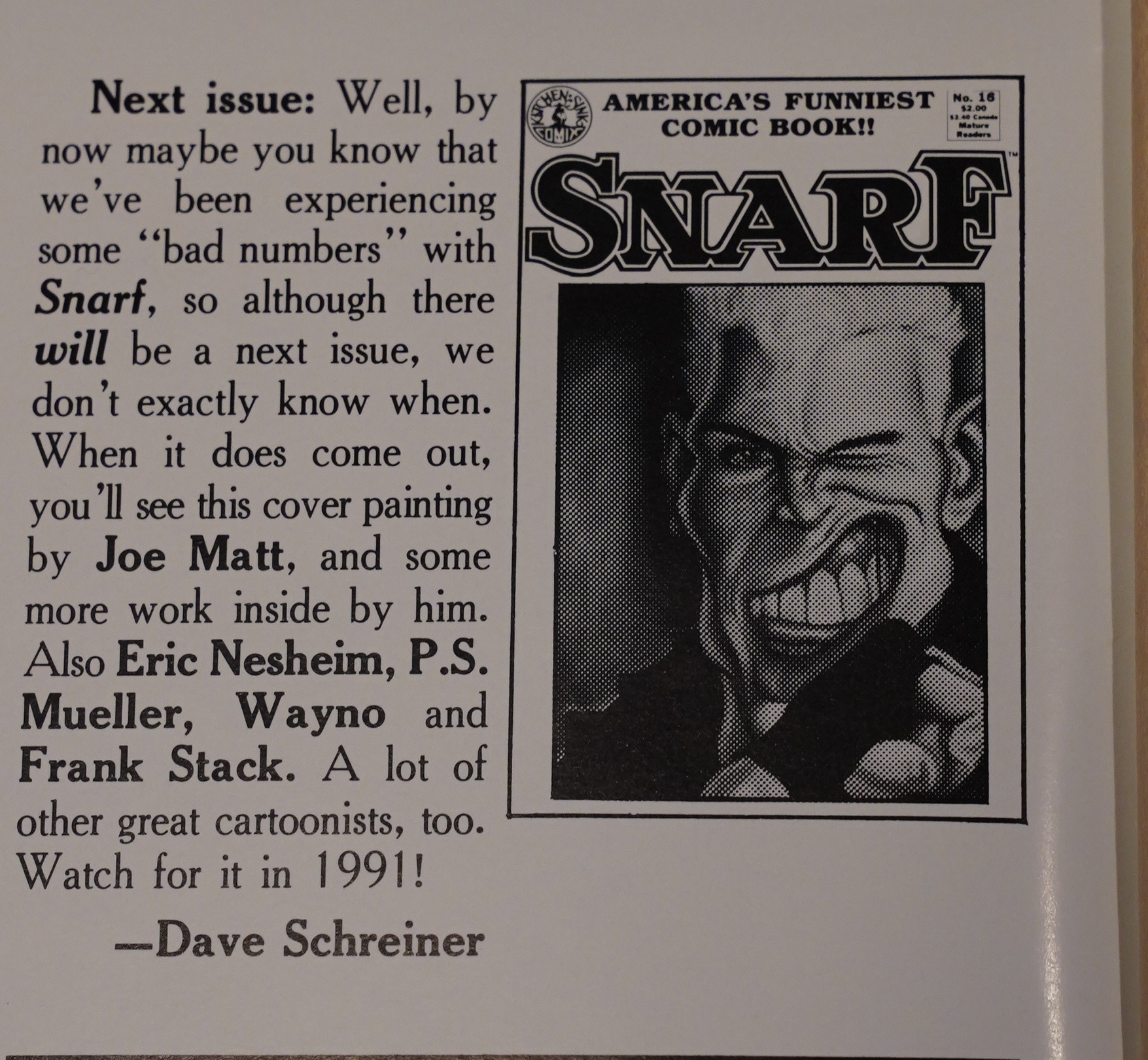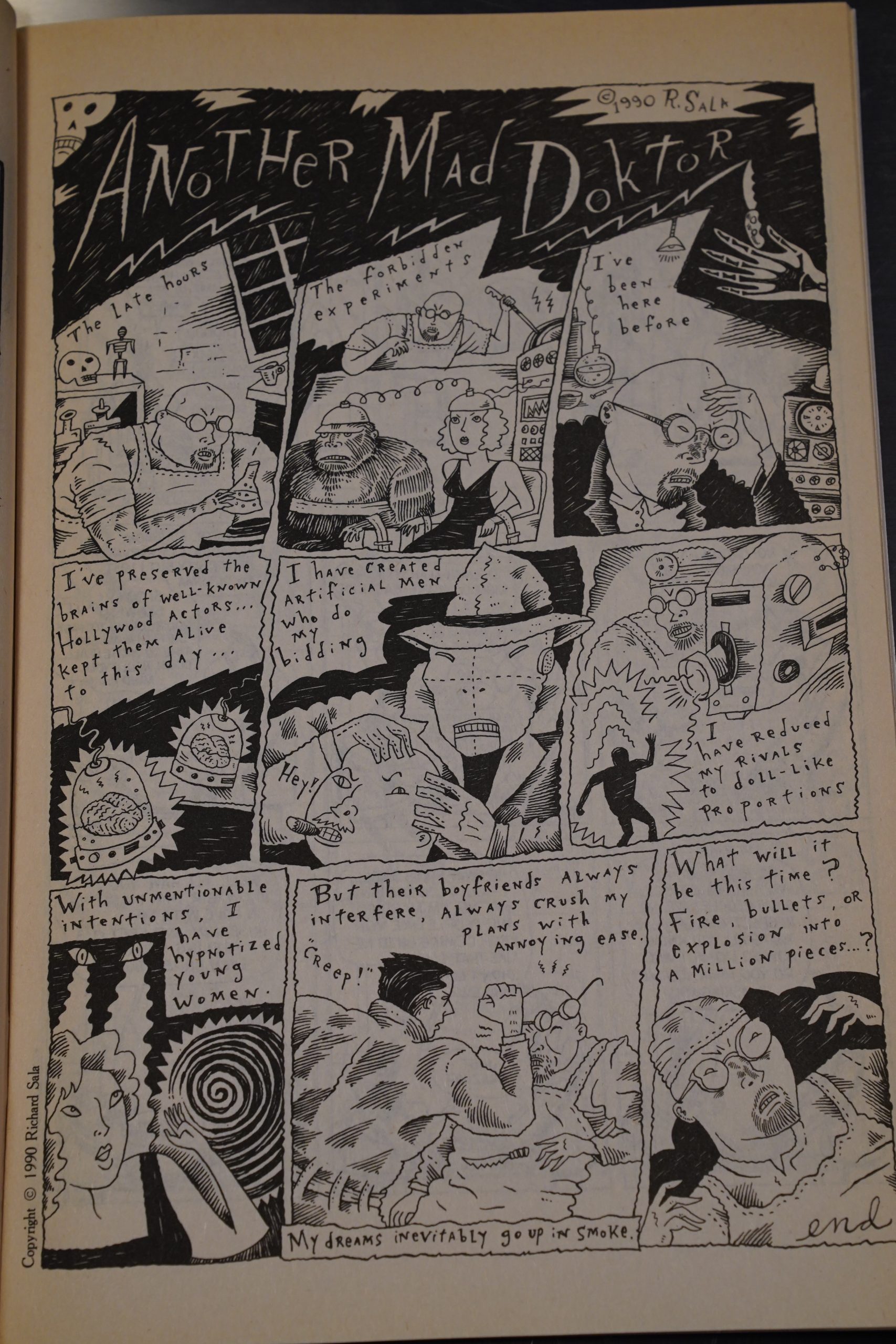Snarf (1972) #1-15 edited by Denis Kitchen and others
This is, in a way, Kitchen Sink’s most long-running series. Not in the number of issues published, but in time span. The first issue was published in 1972, and then issues were published regularly until the start of the 80s, when it took a pause, and then started up again in the mid-to-late 80s and ran until 1990.
So it’s an 18 year stretch.
I had about a third of these issues as a teenager, but the rest are new to me, and I’m excited about (re-)reading these.
Kitchen isn’t a very chatty editor normally — most Kitchen Sink books don’t have a vocal editorial presence. But here Kitchen actually gives an introduction of the artists featured. It’s pretty low key, though.
The name of this book, Snarf, is probably meant to evoke all those other Mad-derived humour magazines? And indeed, we start off with a longer piece by Kitchen himself, and it’s a Mad-ish parody of hard boiled crime stuff. And it’s funny.
But this is an underground comic book, so we get a variation on the “there’s a fly in my soup” schtick that I can’t recall ever seeing before (by Tim Boxell). His other contributions are even more deranged. Amazing!
But the winner in the sheer, incomprehensible drug induced (presumably) insanity goes to Wendel Pugh. He has comics in all the early issues of Snarf, and they’re all nigh unreadable. I’m not sure whether it’s genius or … er… what’s the opposite of genius…
So Snarf is off to a good start: It’s a very solid first issue. Which makes the second issue such a let-down: We start off with a Pete Poplaski thing where the … joke? … seems to be that this is a Polish hero.
Perhaps you had to be there.
Grass Green shows up with his tedious super-hero parody thing, and the rest of the issue is almost as dull.
But at least Kitchen’s honest.
Around this time, Kitchen started publishing Will Eisner’s Spirit, and we’ll get to that later in this blog series, but Kitchen’s gotten a good cover out of him. (Making fun of hippies, of course.)
And Ed Goodman/Pete Poplaski gets in another dig at the hippies: They’re all booshwah fakes, apparently,
The early issues have several strips by Dutch cartoonist Evert Garadts, and they’re… odd. They’re really odd. But funny. This one’s the best one.
And we round off with some more digs at hippies.
Kitchen demonstrates just what makes a comic an underground comic.
A lot of the stuff in the early issues looks pretty rough, and so does this thing by an artist going under the name of “Grisly”. But it’s so unhinged! Fabulous!
And finally things start looking up, art wise: Howard Cruse becomes a regular. First with (what I guess are) reprints of his Barefootz newspaper strip, but he appears in most issues from now on with original material.
Such deals! You can make a minimum of $75K without lifting a finger!
When reading interviews with Kitchen, he often touches upon how Kitchen Sink was seen as being “too nice” compared with the West Coast undergrounds, and he mentions Cruse as being an example. And I guess I get what he means — Cruse draws very cute characters. But… nice?
Justin Green stages a great marijuana debate, but I’m not sure whether this is the great debate?
Wow. An early Harvey Pekar strip. And with a more cartooney art style, courtesy of L B Armstrong, than he’d prefer later.
It’s a pretty untypical strip from Pekar altogether.
Like I said about Cruse not really being “too nice”? Right.
After issue five or so, Snarf is really on a roll. We get one amazing cartoonist after another, and all the weirdos from the first few issues are gone. It’s now totally professional… but still quite odd editorially. It’s no longer really a pure humour magazine, what with Sharon Rundahl’s auto/biographical stories. It’s a pretty fascinating story, though, and I love her artwork.
Snarf switches to white paper from newsprint, too, which makes things look sharper.
Rundahl criticises underground comics.
We get, basically, a whole bunch of underground artists that you’d expect to see, like Trina Robbins, which is always nice.
Kim Deitch does a number of three-ish-page strips that are all quite puzzling. Many of them don’t really go anywhere, and seem to want to be expanded into longer pieces.
Heh. A strip by Art Spiegelman and Françoise Mouly.
That’s a good Little Lulu (from Howard Cruse).
Like I almost said about Rundahl up there — these pieces are pretty incongruous in this context. Here’s a story about a tragic ballet dancer, and… I mean, it’s really good, but I wonder what Kitchen’s editorial policy here was? Just soliciting his favourite artists for work, without any sort of guidance as to content or theme or anything?
But the thing is, these issues read really well. This strange mix of randomness doesn’t feel off — it feels natural, somehow.
Hey! Didn’t I read this Rick Geary piece about Charlie Chaplin somewhere else recently?
The final issue of the “classic” Snarf run petered out in 1981, with each issue published with a greater lapse of time between them…
… but then in 1987, the title is resurrected (and is back on newsprint again), and has a new co-editor Dave Schreiner. (I’m guessing that Schreiner took over completely by the end.)
It’s a new era, and we get a whole bunch of new contributors, like J D King…
… and Mary Fleener contributes an awesome one-page strip. Cubismo!
PS Mueller does a whole lot of pages for the revamped Snarf, but starts off with some gag cartoons. The rest are more traditional comics, and are really… odd. I mean, in that they read quite straightforwardly, but seem to be about nothing.
The first issue of the new Snarf is chock-a-block with new, hot talent, like Chester Brown.
And a random Omaha the Cat Dancer five-pager?
Some of the older generation of comics artists show up, like Jay Lynch, but it’s mostly new people.
… and Howard Cruse, with the infamous Creepy Snuff Porn strip, where he puts the Meese commission on porn into a stack and stabs, rapes and kills them off. I seem to remember this strip being… er… slightly controversial at the time?
In fact, my favorite storyfrom Dan-
cin’ Nekkid with the Angels is
‘ ‘Creepy Snuff Porn, ‘ ‘ a story that suc-
ceeds precisely because its single-
minded vicious attack is so over-the-
top that it passes beyond disgusting
into the realm of the kinda cute.
—CWM
The Comics Journal #117, page 63:
Snarf itself is an amusing amalgam
of contributions from a new generation
of idiosyncratic talents. Although a few
Of them might disagree, a number are
relatively well-known and “established”
artists. Howard Cruse is represented by
“Creepy Snuff Porn,” a spirited, rude
defamation of the Meese Commission by
an artist outraged by the findings and
recommendations of that Commission.
The piece has the impassioned effrontery
of the most audacious underground mate•
rial of the ’60s, and in the era of Reagan
puffery, it’s a relief to encounter genuine
anger.
Or perhaps it wasn’t controversial at all?
The sheen of Rand Holmes’ artwork is something to behold.
Mark Landman’s doing his computer artwork stuff…
… and Dennis Worden is really, really deep. I mean, you can’t get any deeper than regurgitating creationist talking points, can you?
An independent thinker if I ever saw one.
There was something in the air around this time? Several strips with teensy teensy panels. Did this come from a Mark Newgarden influence, or was is just a mini-comics thing? Burk Sauls does a pretty neat page, anyway.
But the major news here is… Joe Matt! I had forgotten that this was the venue he pioneered his early autobio strips! He’s in all the final five issues, doing this stuff, and it’s awesome.
Cruse takes a harrowing look at the Nancy pelt industry.
Is Frank Stack underrated? I don’t know; I think most people like his stuff, so perhaps he is correctly rated… but I just adore his line. Look at those houses in the first three panels? Gorgeous! Look at those stairs in the fourth panel with the different hatching on every step? I love it. Every panel has something to gawk at.
Gary Dumm is more … er… draws less attention to his line. But here’s a rare Dumm/Crumb/Pekar page.
A reader, in the first and last letters page in Snarf, calls Worden out on his bullshit.
So, the revived Snarf started out with huge enthusiasm, but then it falters, and we start getting… cheaper fill-in material. Like reprinting some Basil Wolverton.
And translating some Edika from French. I mean, I’m not complaining, because this is just totally perfect and awesome, but I think this probably means that Snarf wasn’t selling any.
It’s not that these are bad issues or anything. They’re chock full of great stuff and surprises like Sharon Clayman and Al Via’s very edumacational strips.
*gasp* Gerald Jablonski! This is not as insane and unique as his later work has become, but it’s still sui generis. Fantastic.
Joe Matt gives us some further tips.
Schreiner says there will be a 16th issue, but that never happened. Fantastic cover by Joe Matt, though.
*gasp* Richard Sala.
And then the series is over.
It’s a pretty weird series — it started off strong, then it floundered, and then it became a really solid 70s underground anthology, before being resurrected as an even better late-80s alternative anthology.
But it didn’t really have a strong identity? Howard Cruse is the artists that appeared in most issues, I think, but beyond that, there’s not really a lot to tie things together.
The Comics Journal #63, page 226:
SHERMAN: I guess for my final question, briefly: how
would you produce an average Krupp title, like one Of
your anthology books?
KITCHEN: Well, anyone who reads our titles regularly
knows that I have certain favorites and certain regulars
who I like to use, who I tend to use more than some of my
competitors, and they have their own favorites. Still, I
try to inject new talent into the anthologies. I try to
devote several pages an issue to fresh faces, and on the
other hand try to resurrect some of the “Older” talents
who dropped out of sight for one reason or another,
people like Justin Green and Kim Deitch, who are not
very active.
SHERMAN: The Banzai book.
KITCHEN: That’s right. If it’s a theme book like Dope
Comix or Bizarre Sex or Corporate Crime or something
like that the basis for starting a book is to ask someone
if they’re interested in doing a story for this title, and
they may say, “No, but. I’ll do something for Snarf
because I’ve got a funny story; I think you’ll like it
And so I have a complex set of charts in my office on
which try ‘to keep a running track of titles. Since
they’re not monthly and I don’t have cover dates I never
have to worry about rushing something to press by
September 1st or be at the mercy of a “national” dis-
tributor.
SHERMAN: So, gathering enough material for an issue
is sort of a cruise?
KITCHEN: I wouldn’t call it a “cruise.” The lack of
firm deadlines is simultaneously a strength and a weak-
ness. A single slowpoke artist can hold up a book when
other contributors have conscientiously submitted their
material on time. This can cause a title to drag on
interminably at times. Death Rattle #4 is five years in
the making. Now I do try to put out the titles at least
annually. The Spirit is the only book I do that has a
schedule, the others I put together as quickly as is
realistic. Partly Pm limited by our schedule which by
now calls for one and a half or two books a month and
that’s determined by, basically . cash flow and circulation
reports and that changes. When the graph is going up ,
I average two or three titles a month; when the graph is
going down, I average one or two books a month—but I
digress here.
Steve Monaco writes in The Comics Journal #116, page 62:
Kitchen Sink puts out some of
the most underground-like titles
being published today, but they’re
also one of the very last publishers
to put out the genuine article as
well. And this time around, their
most noteworthy title by far is the
latest issue of Snarf, one of the last
anthology undergrounds to remain
an on-going series. Sadly, and
somewhat ironically, this most
recent issue of the first
one published in years, is by far the
title’s best, so—wouldn’t you
also the last issue of the
title’s run. Snarf says its goodbye
grandly, though, and the book
serves as both a warm, fitting
farewell to undergrounds them-
selves and a fine example of what
made the best of those old comics
so memorable. Unlike earlier
issues of Snarf, which tended to be
erratic, the quality of the work
published in is consistently
high. Still basically a weird humor
title, the new issue has good work
by Chester Brown and the Fried-
mans, a truly great cover by Will
Elder, and a piece on the Meese
Pornography report by Howard
Cruse that no one should miss.
Until this issue, I was never a big
Snafffan, but now—if this really
IS goodbye for the title—I think I’m
going to miss it quite a bit.
Ah, Snarf 10 was originally meant to be the final issue? I guess that explains why that issue in particular was so strong — a final send-off.
But then they made more, which was a good choice.
The Comics Journal #111, page 74:
RINGGENBERG: wæs “Suffering Celeste”
intended for the regular Barefootz title that you
CRUSE: No. I had Snarf in mind. But
Celeste was long, 12 pages. Denis felt a Story
I’d done for an earlier Snarf had been just
too long for the book.
RINGGENBERG: Which one was that?
CRUSE: “Cream of the Genes” in Snarf
The book didn’t do well despite a Kurtzman
cover, and Denis felt that taking up nearly
half the book with one Story hadn’t been
a good idea. So “Suffering Celeste” was
handicapped in finding a slot. Then the
Supreme Court decision came down and
made it all moot.
Then when Denis offered me the chance
to do Barefootz for Comix Book, “Celeste”
was still far too long. Besides, it didn’t have
tones, and Stan Lee wanted Barefootz to
have tones. And the passage of time had
changed my style. “Suffering Celeste”
looked wrong. It looked primitive.
However, the real reason I didn’t include
“Celeste” when I finally got around to put-
ting together Barefootz Funnies was that
had become aware that parts Of it might
come across as sexist.
RINGGENBERG: Like the bit where Bare
footz loses his temper and pins Celeste to the
wall with a chair?
CRUSE: That’s Barefootz’s only little
moment of macho, and it’s quickly under-
mined. And the fact is, it was satirizing
machismo. Barefootz wasn’t being himself;
he was playing the role of Ramrod. But the
fact that Celeste reponded positively to his
violence, that it got her hot, was something
that I realized wasn’t going to go over too
well in some circles.
It would’ve been a different matter if I
thought women would be wrong to be
annoyed. But, despite my good intentions
when I drew it, I wasn’t at all sure they’d
be wrong.
Y ‘know, Steve, this is going to seem like
a strange conversation to people who read
this. No one has read the Story that we’ve
been talking about!
This is the thirteenth post in the Entire Kitchen Sink blog series.
